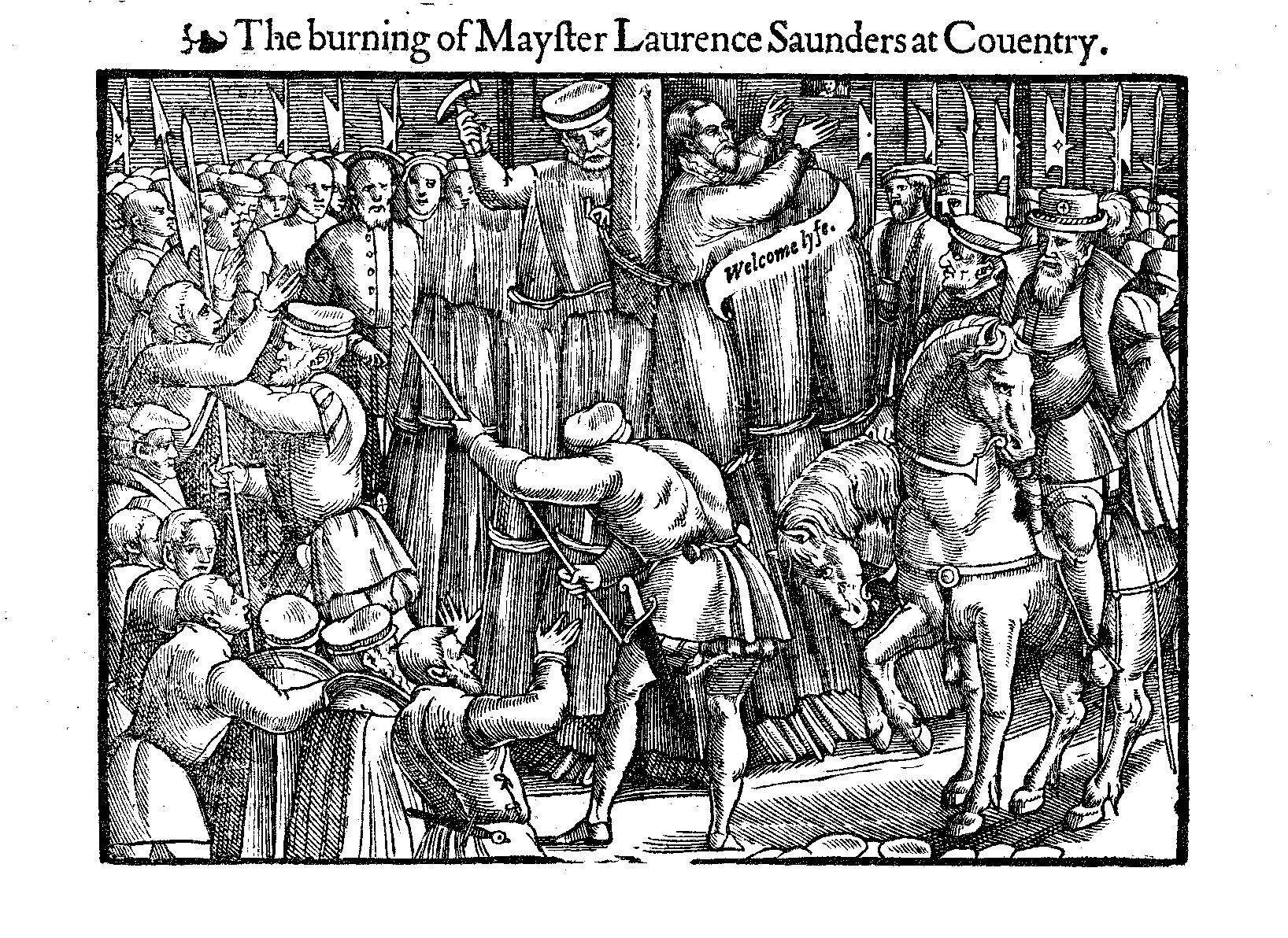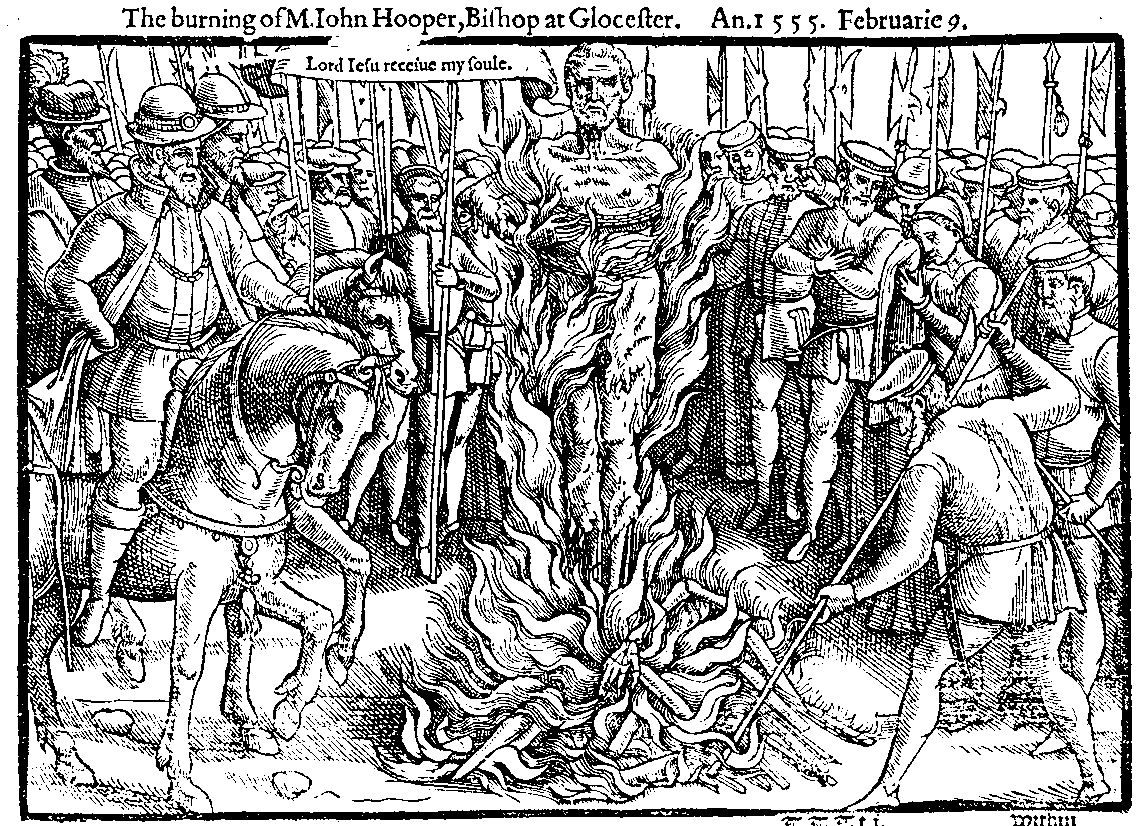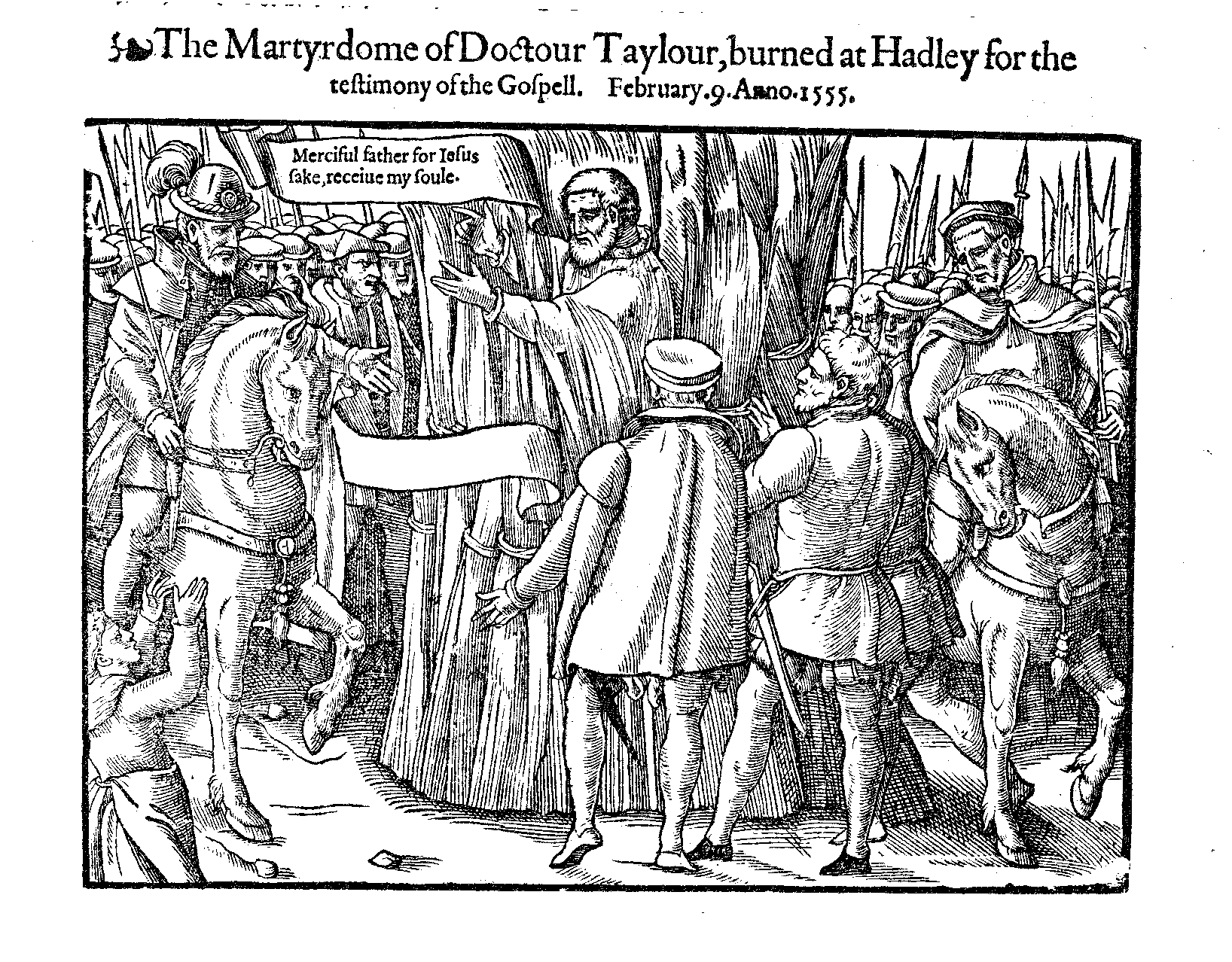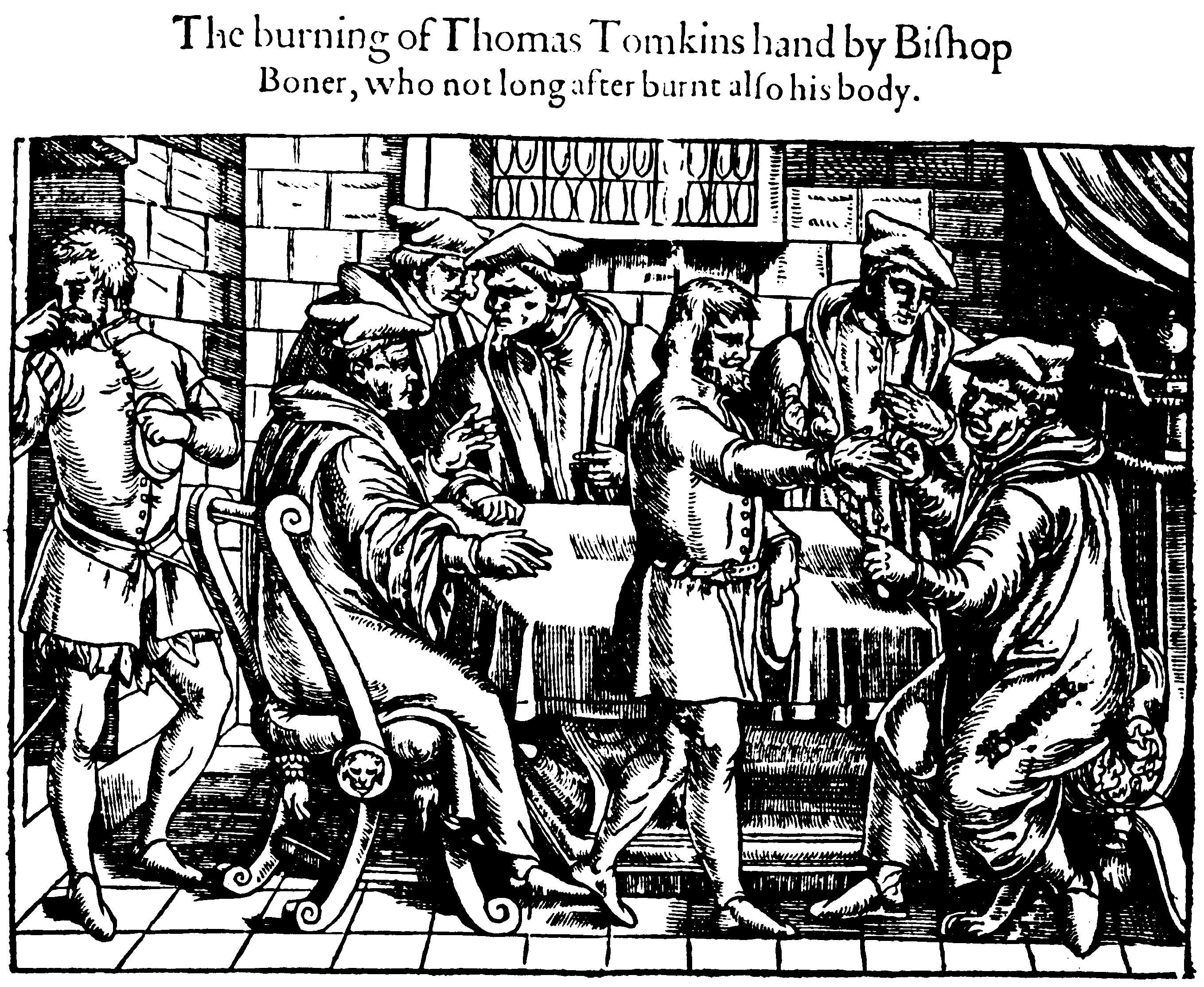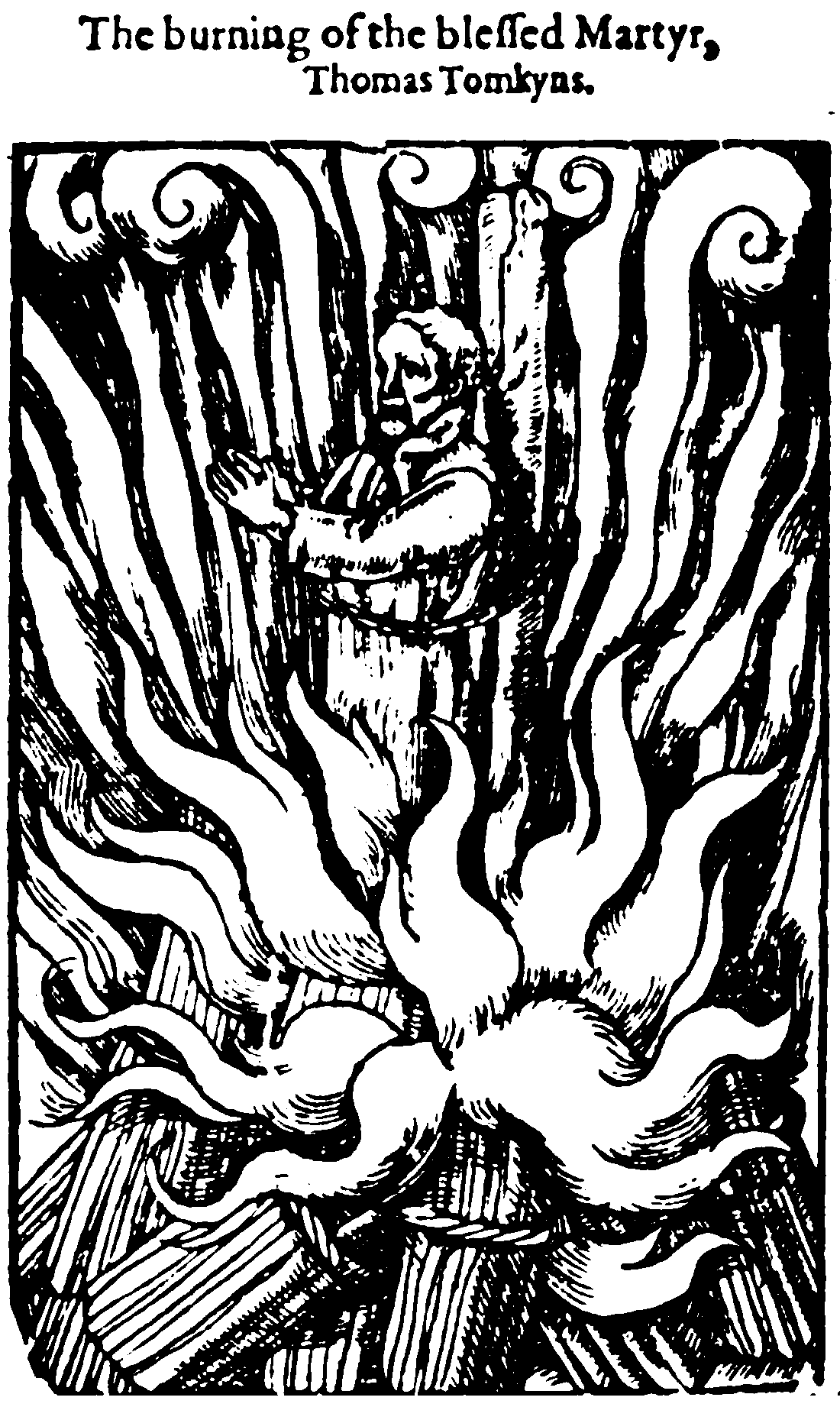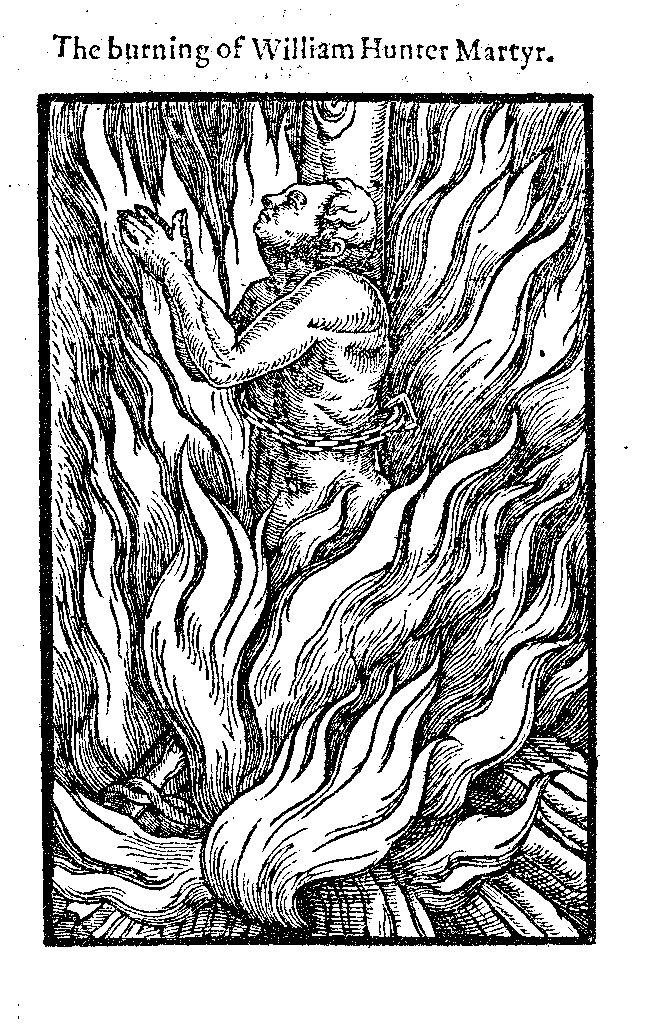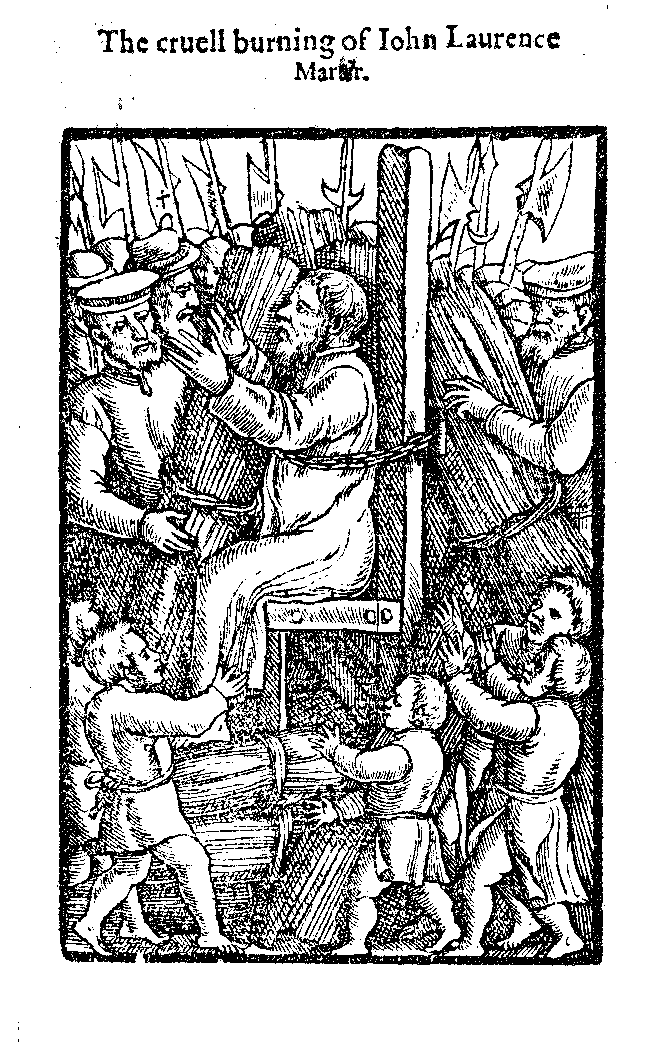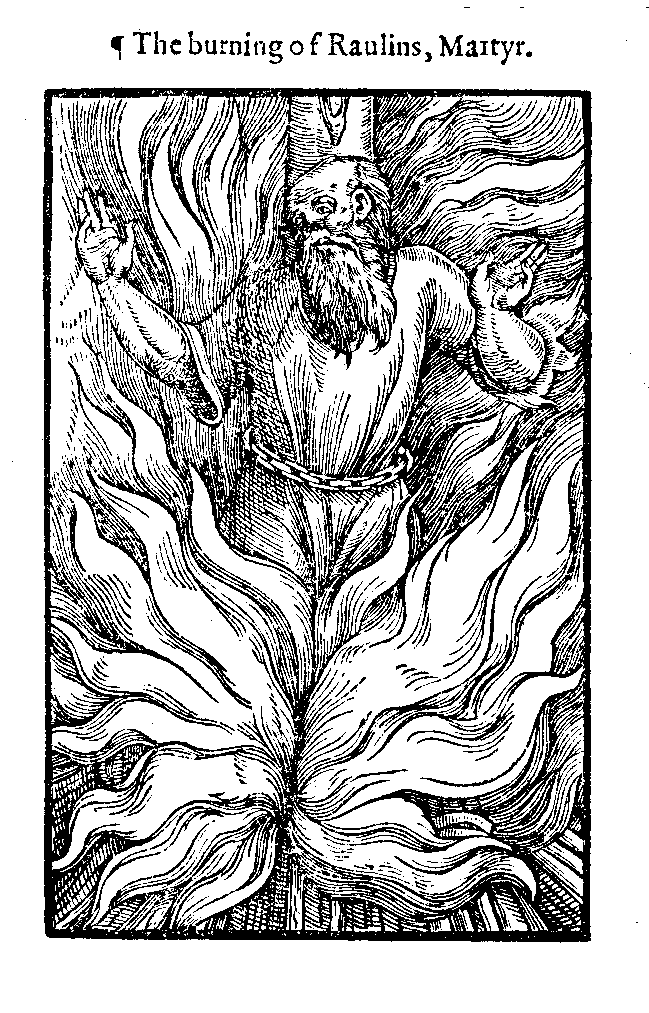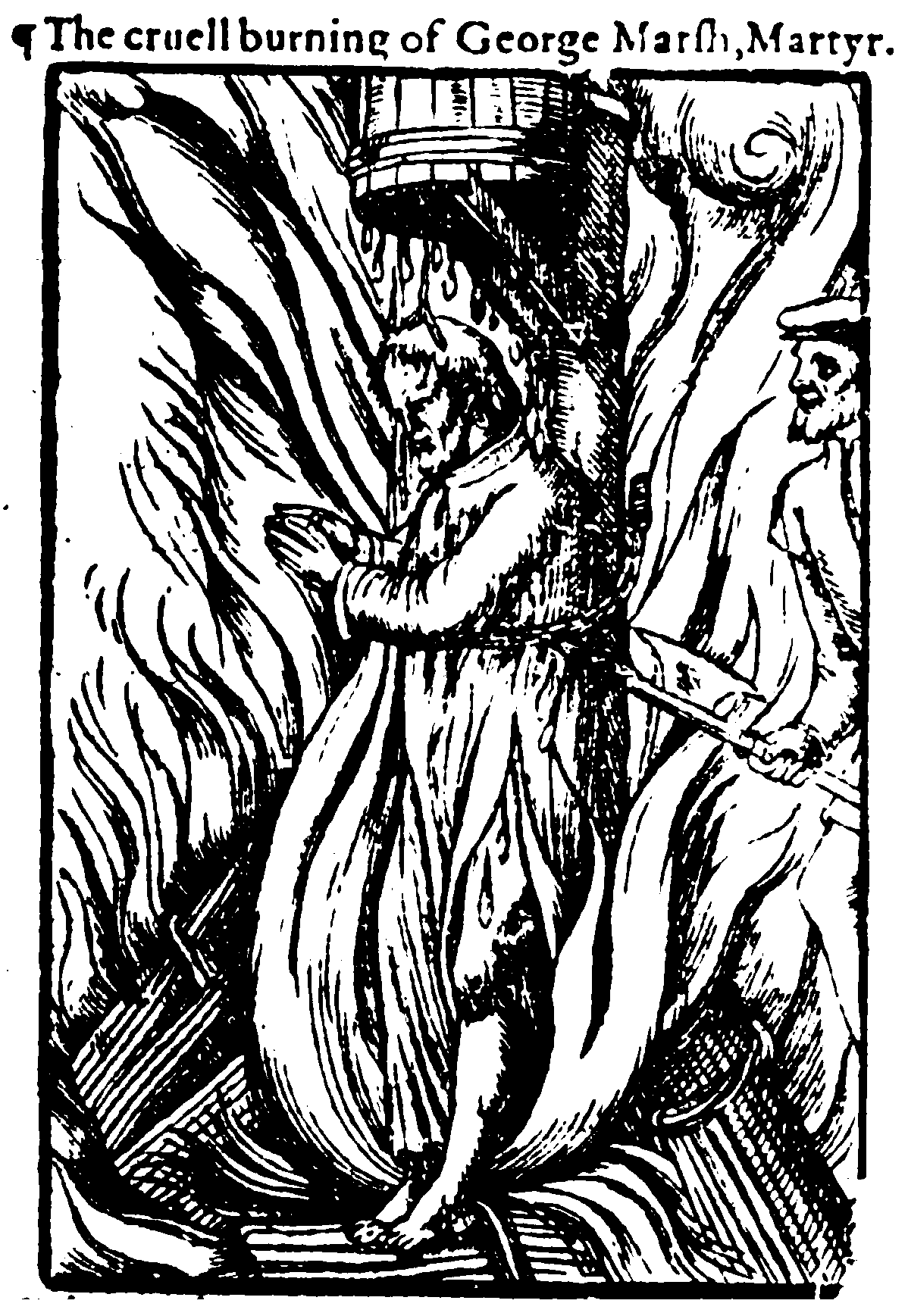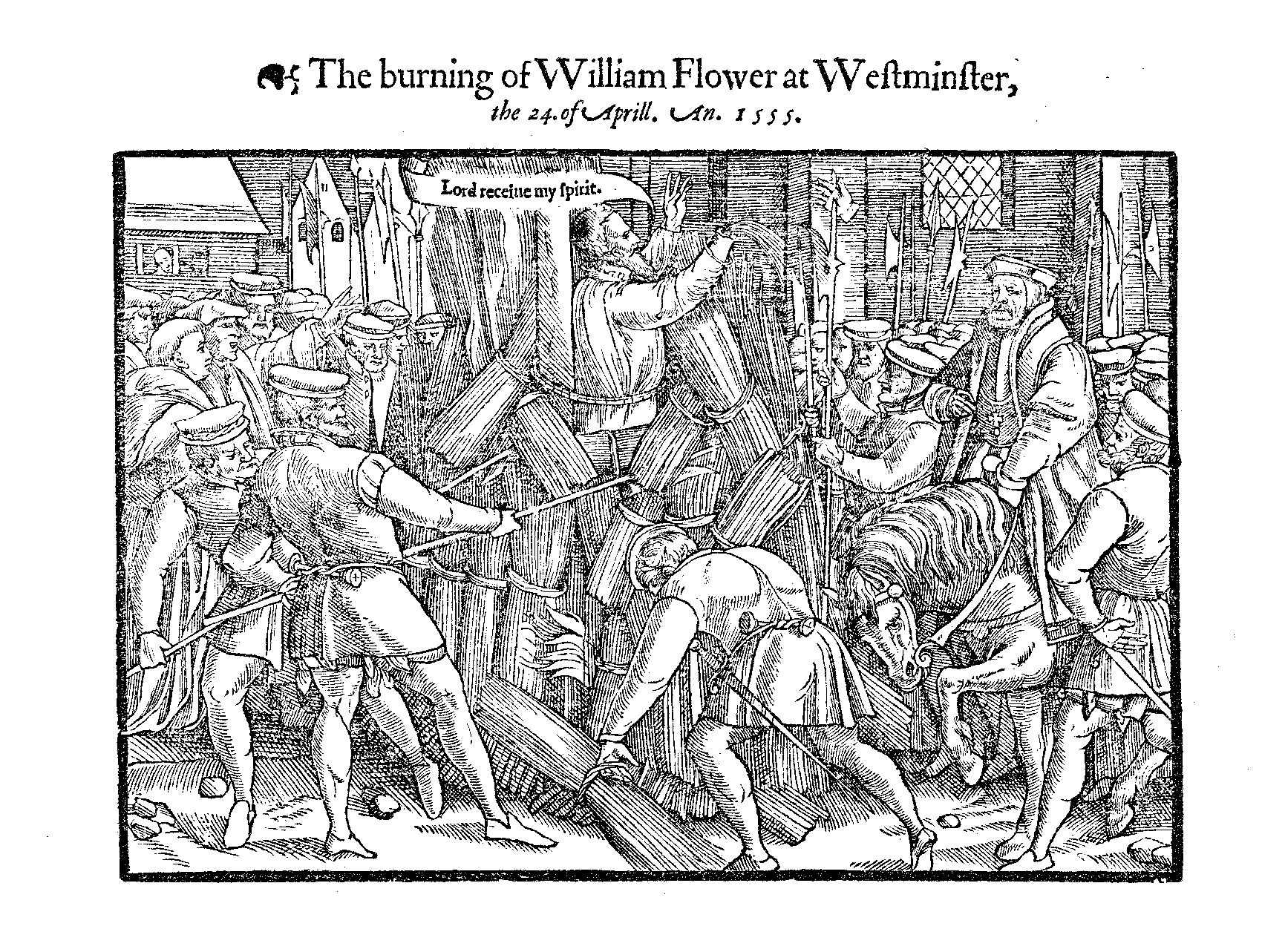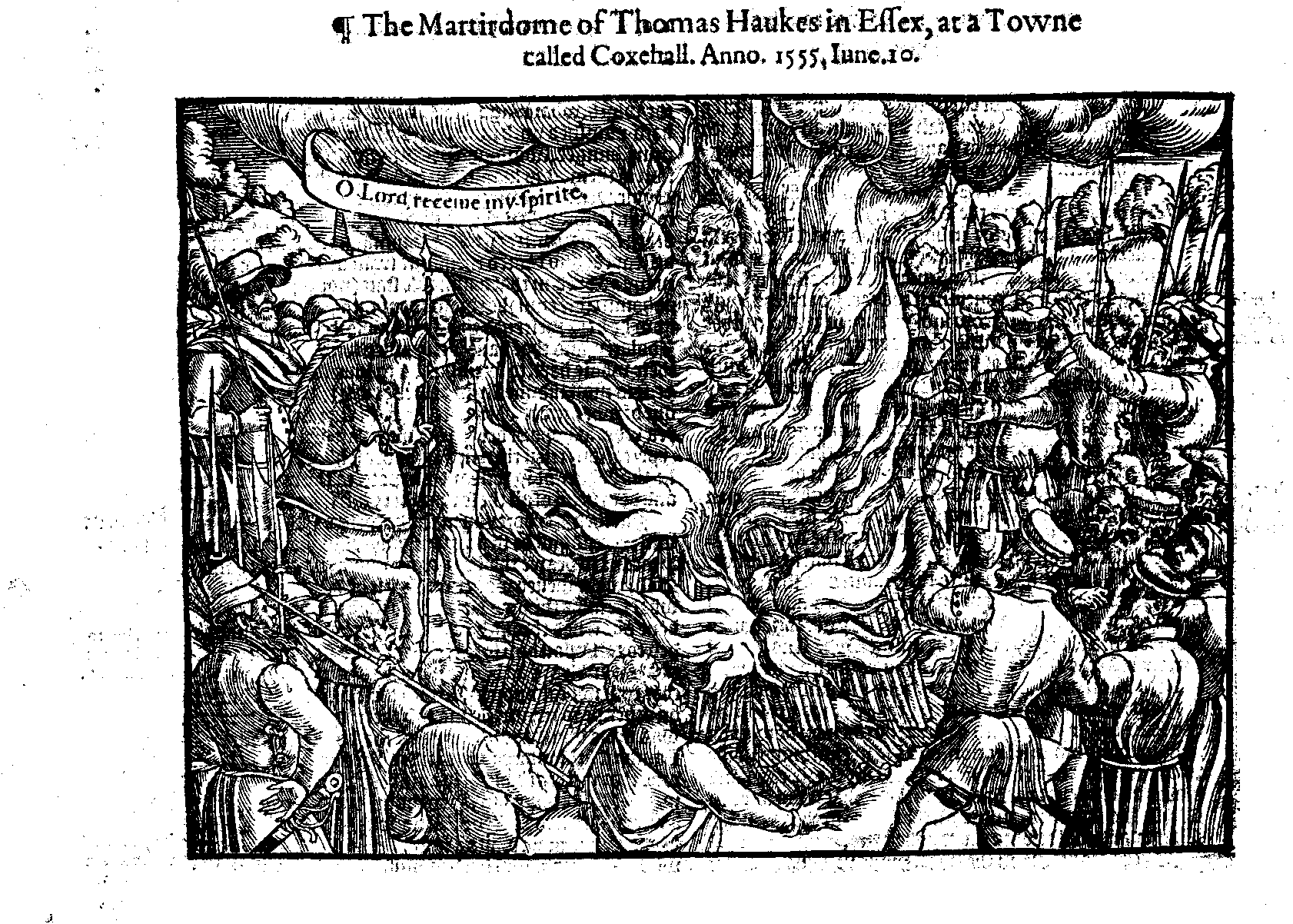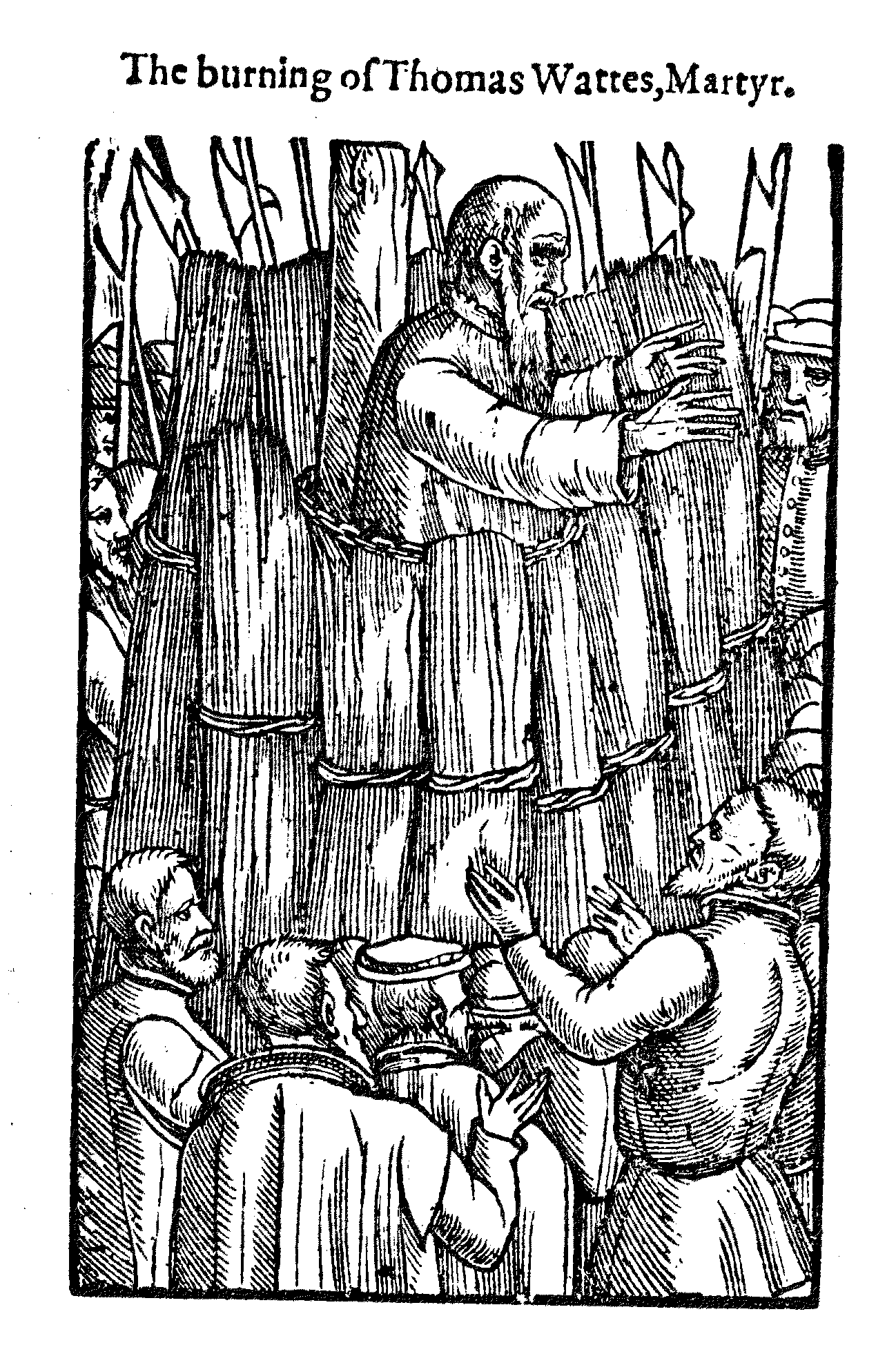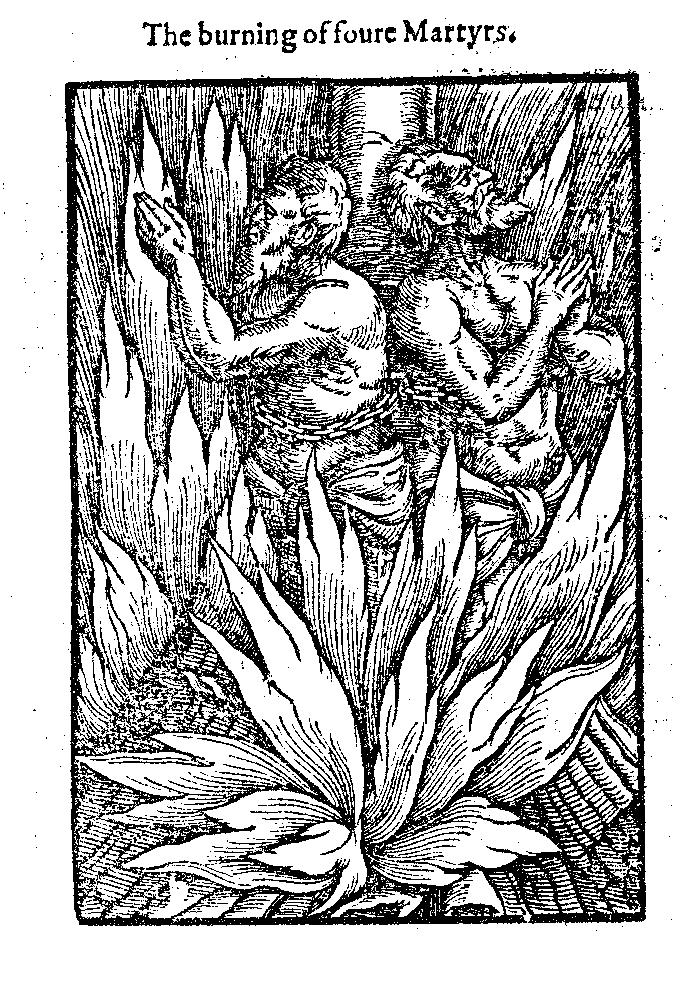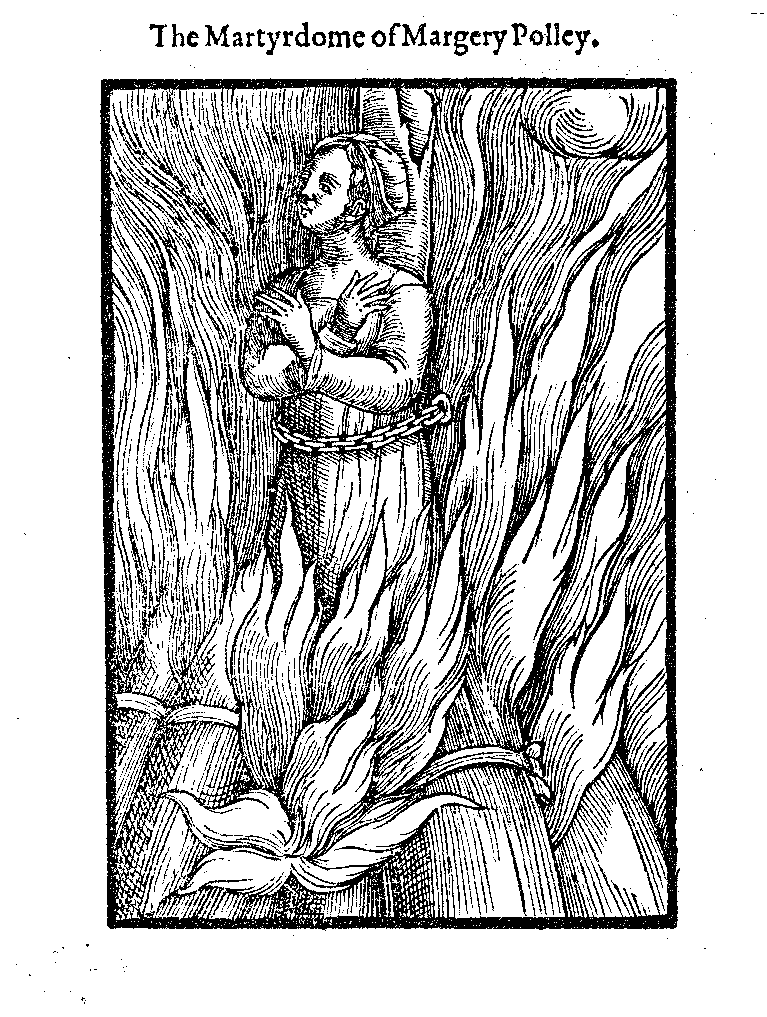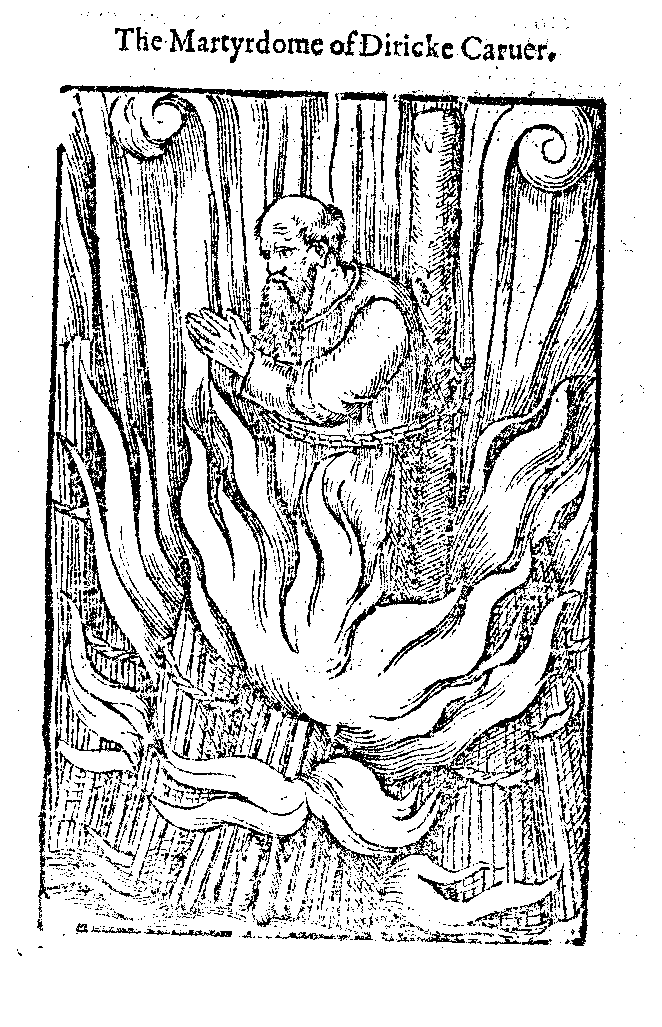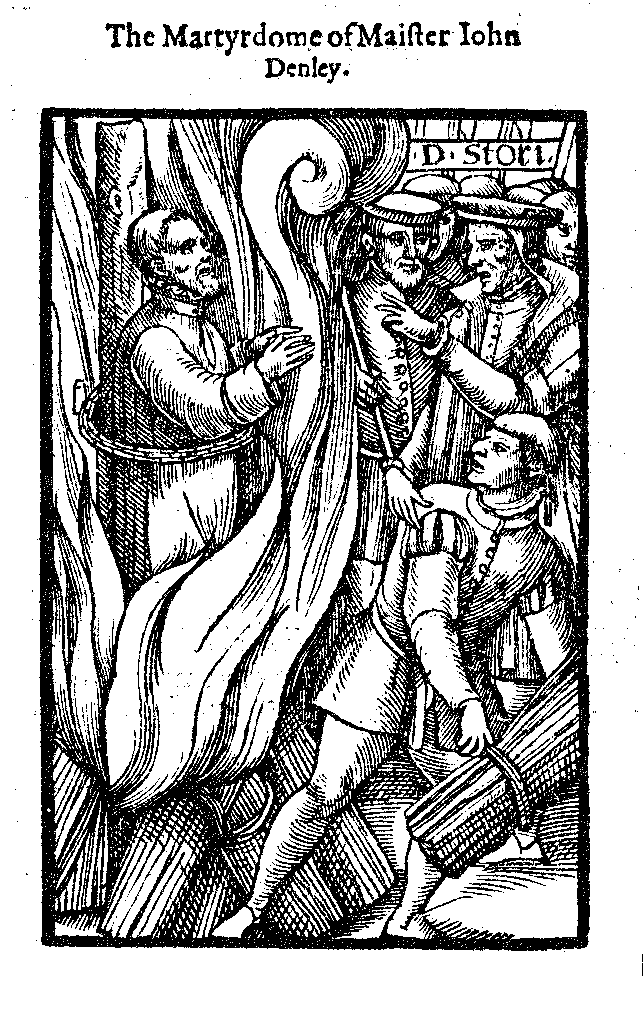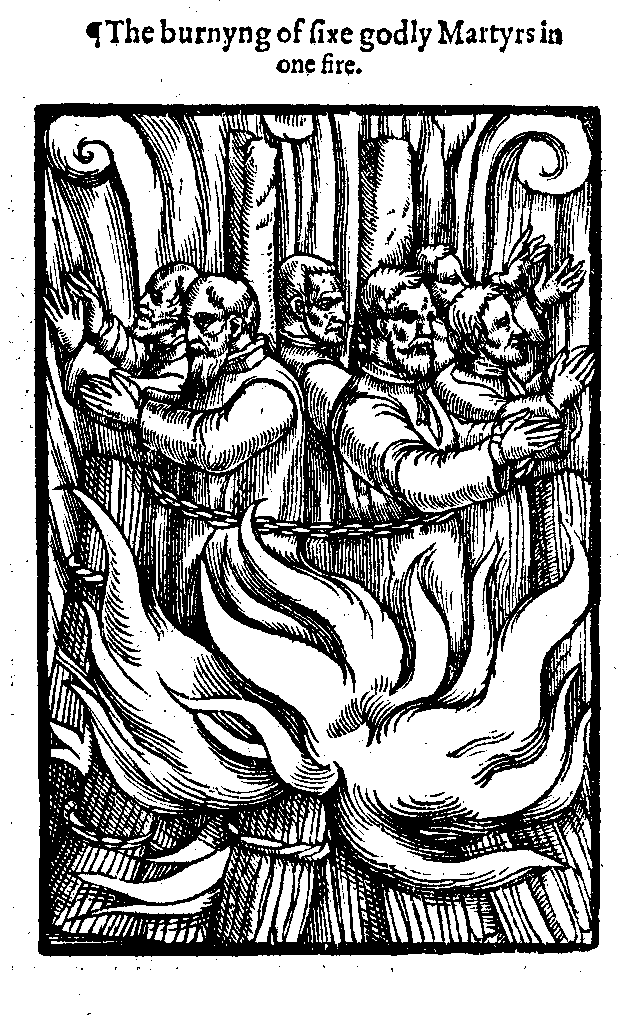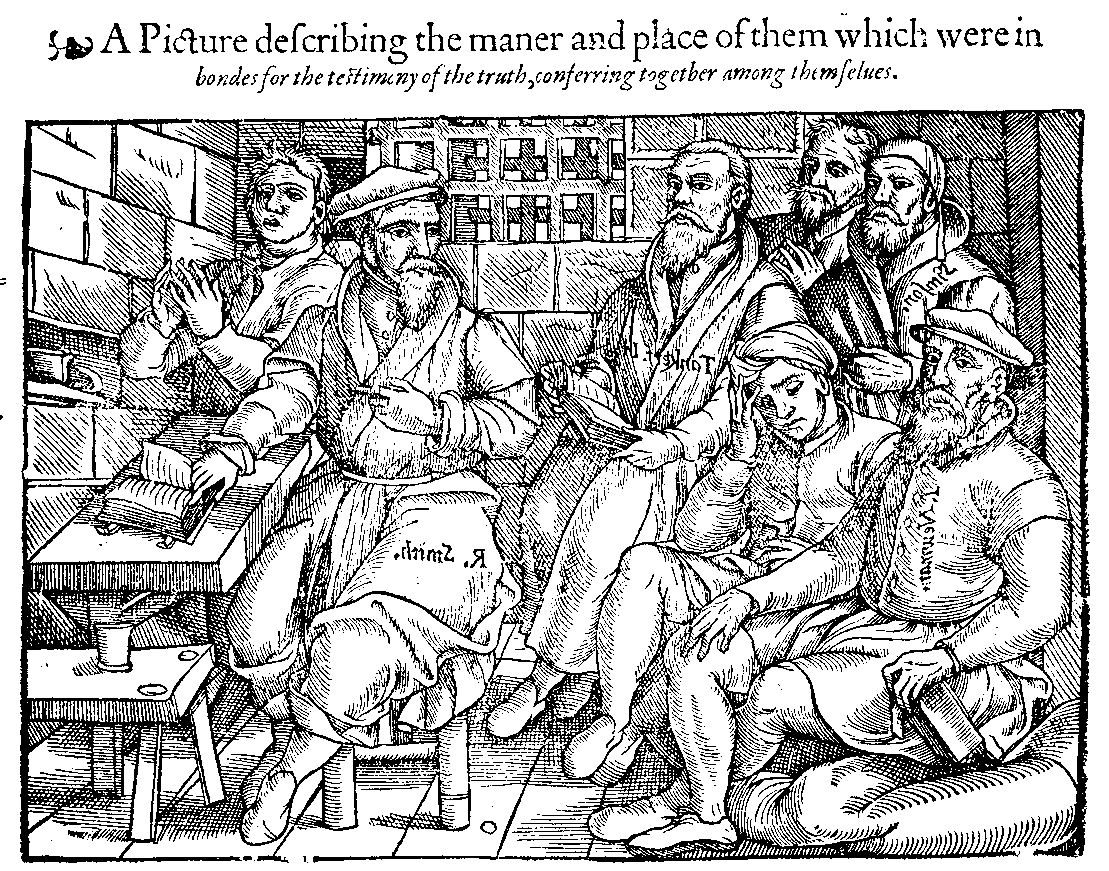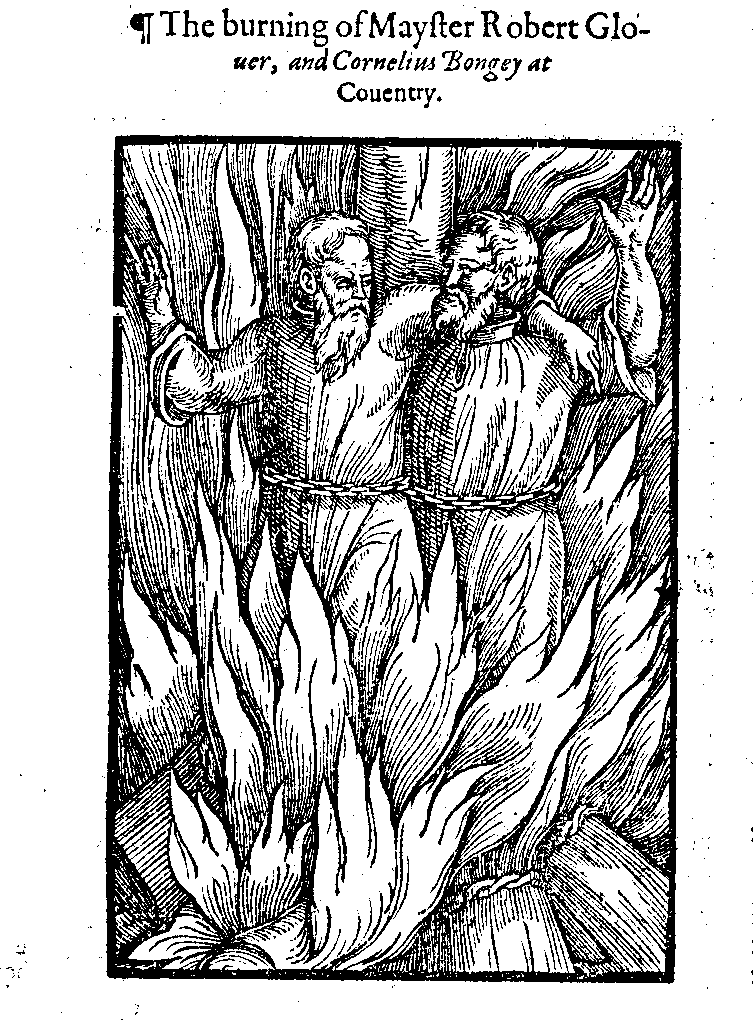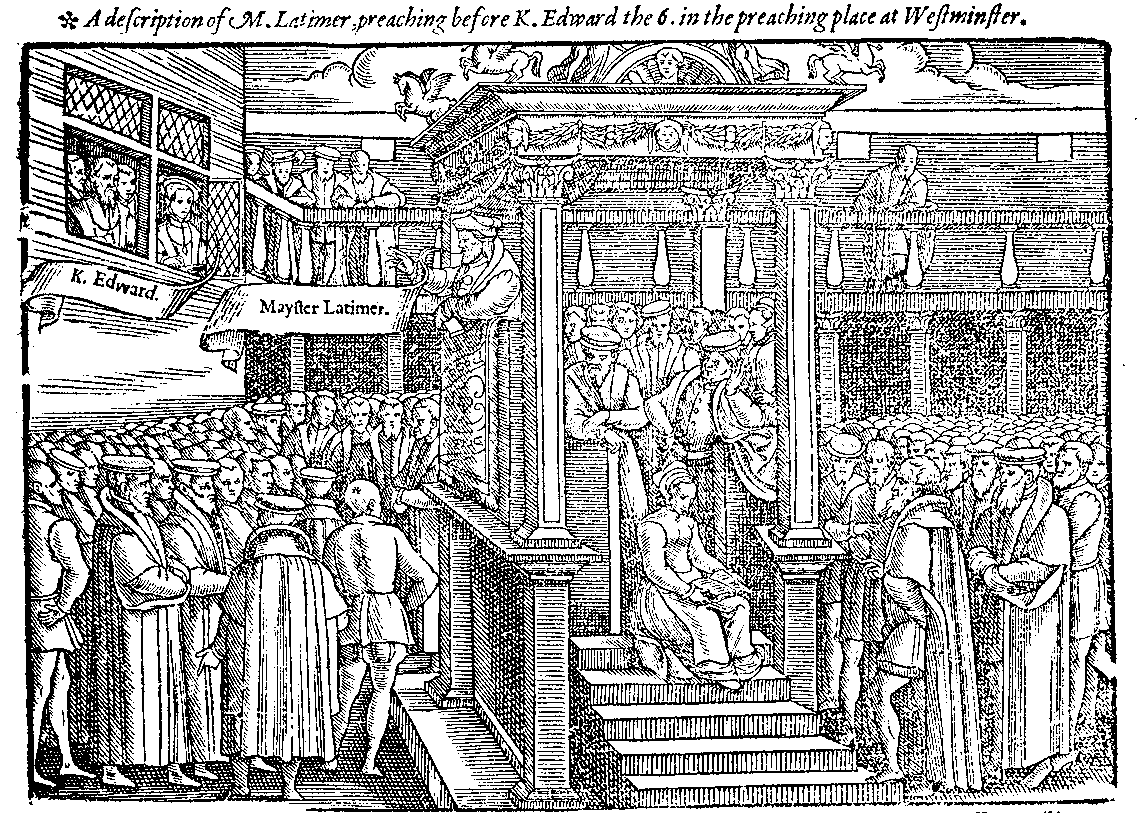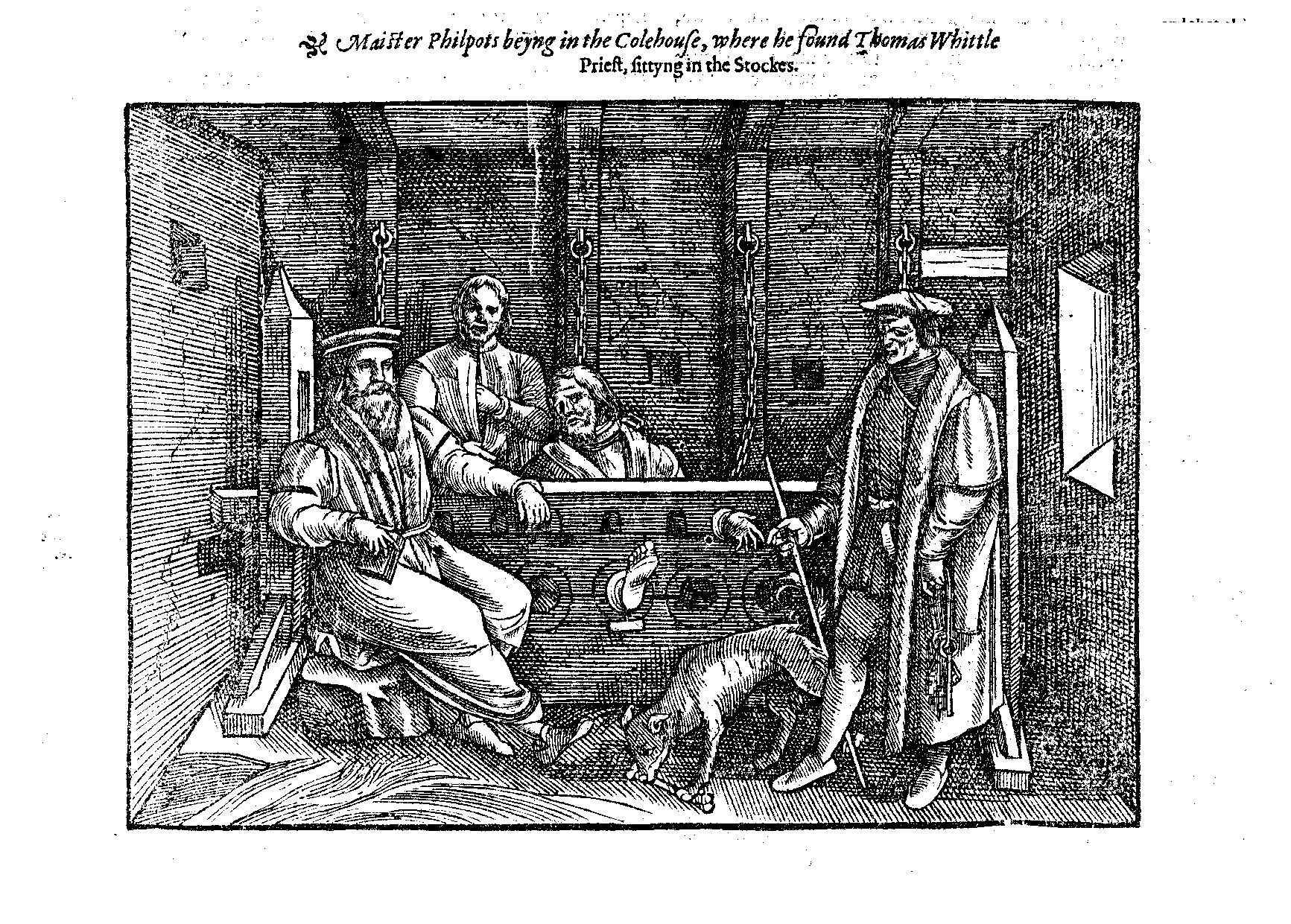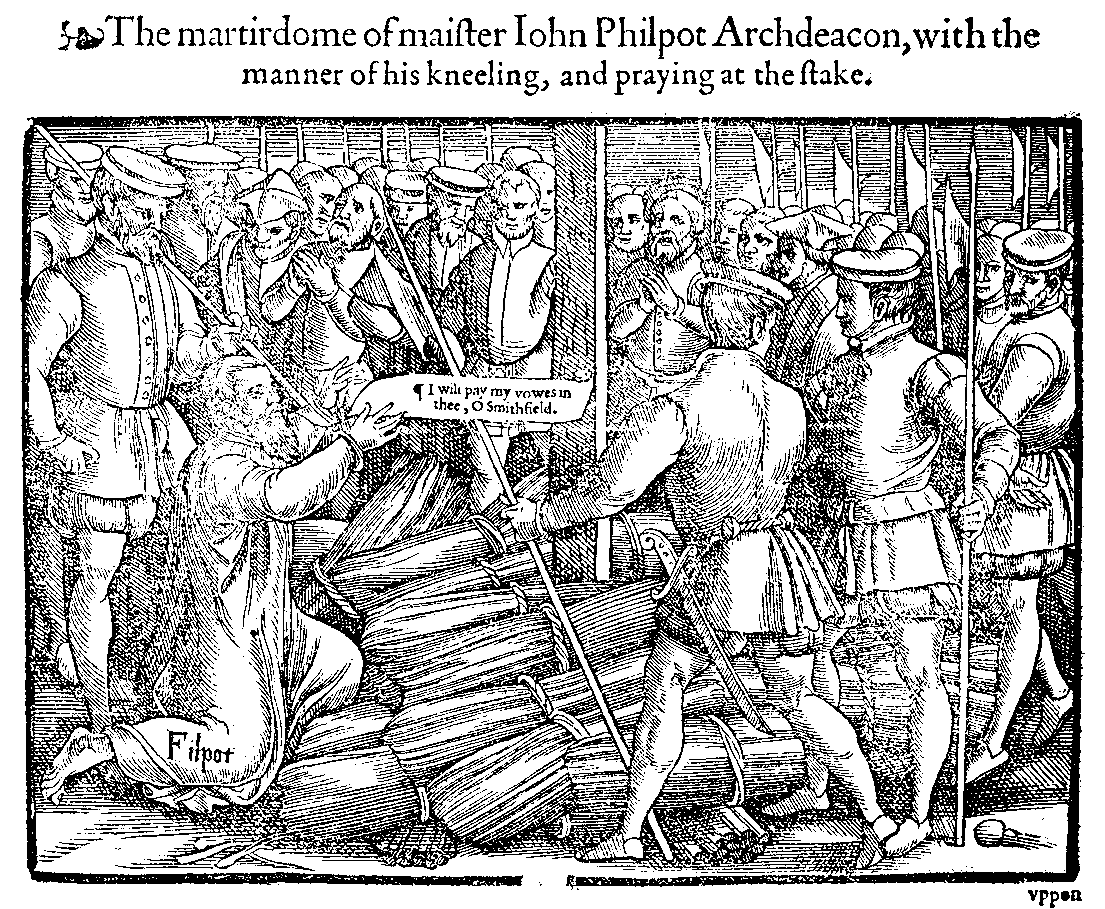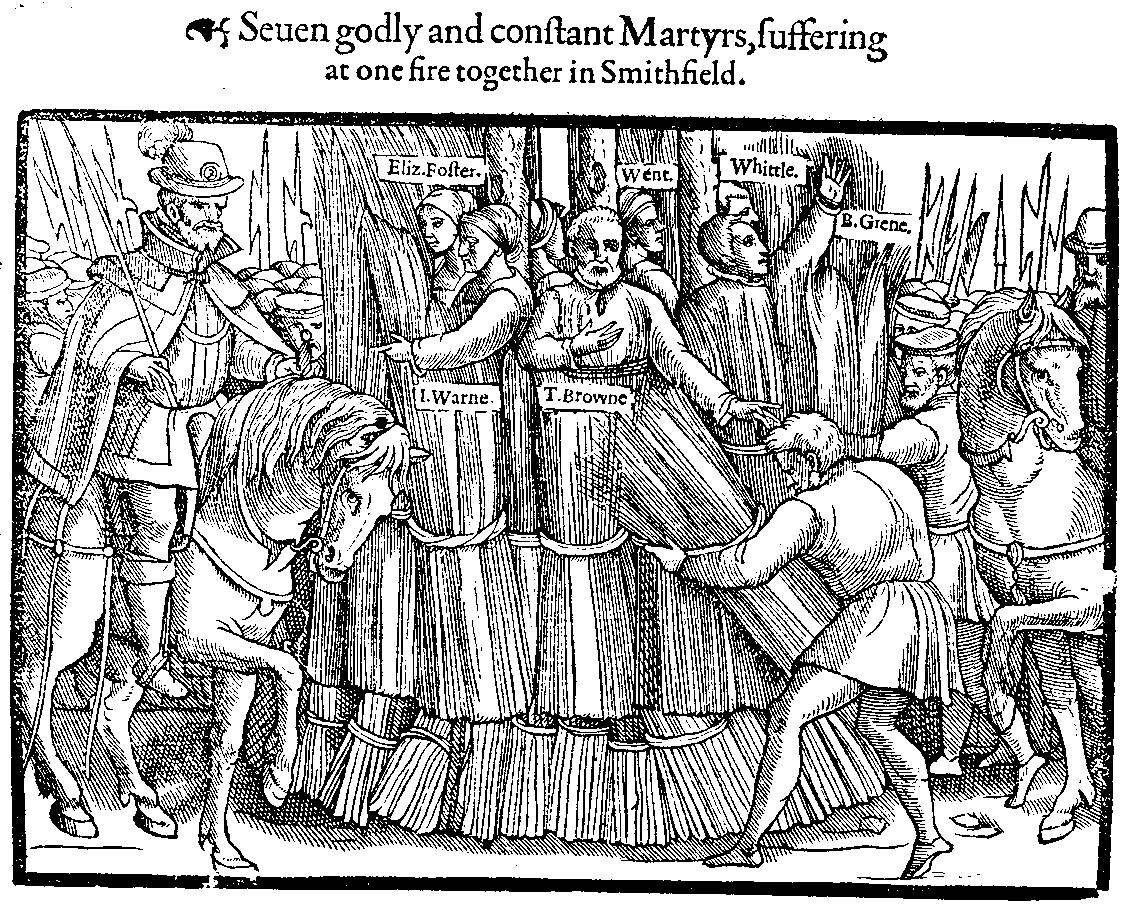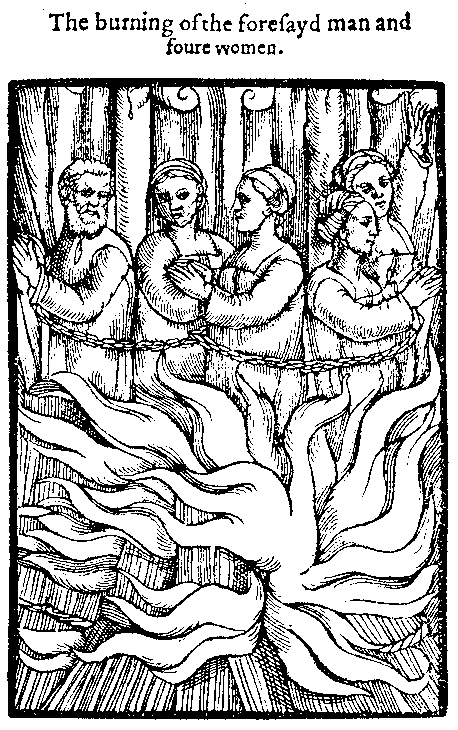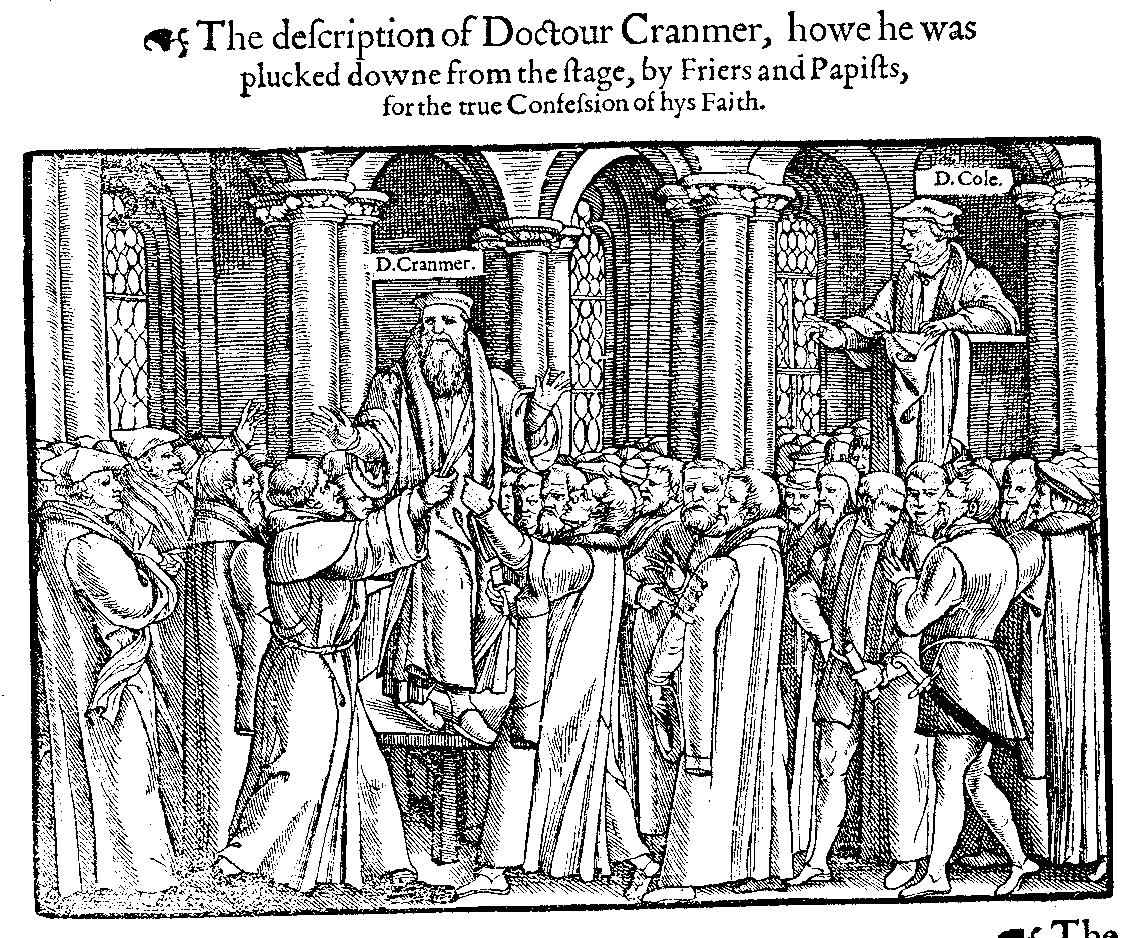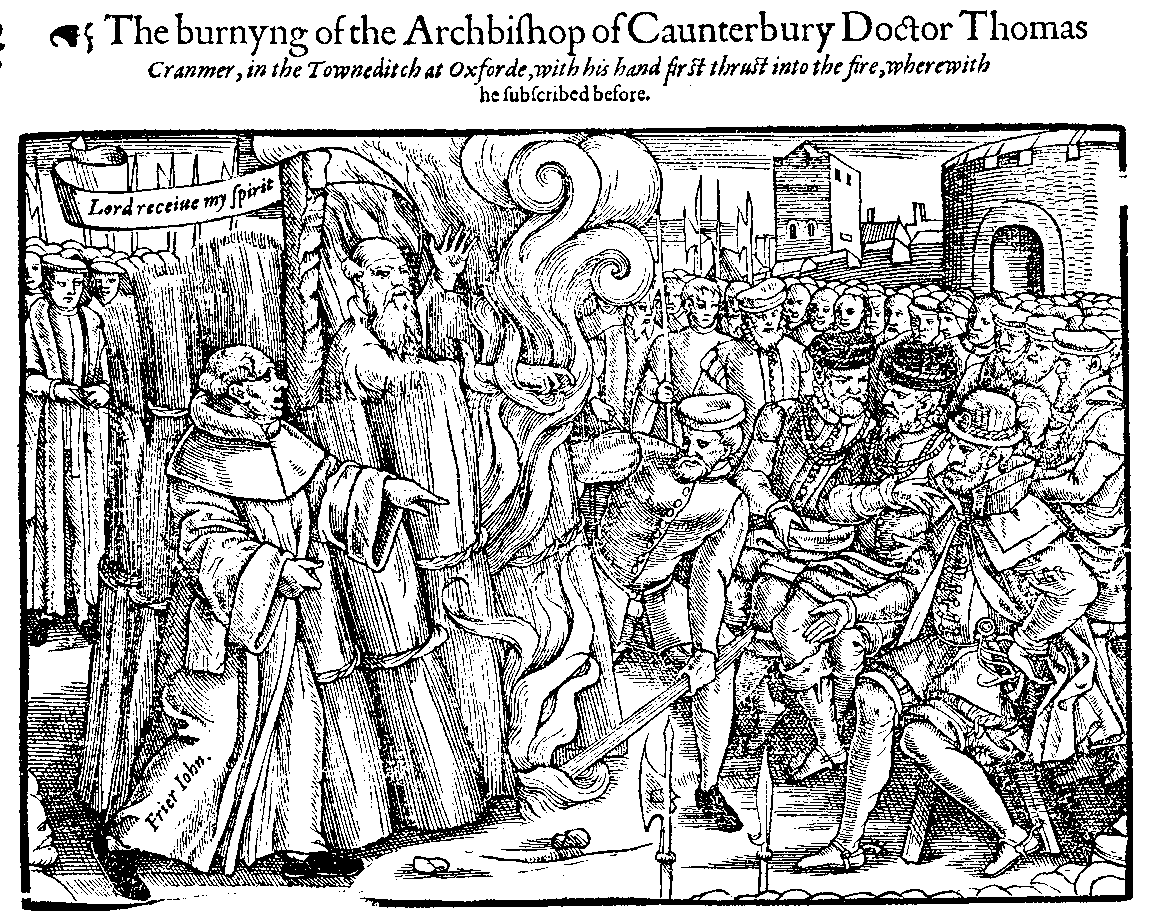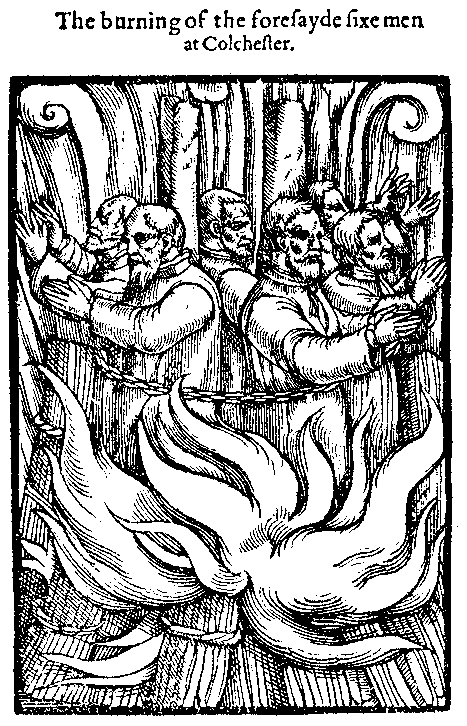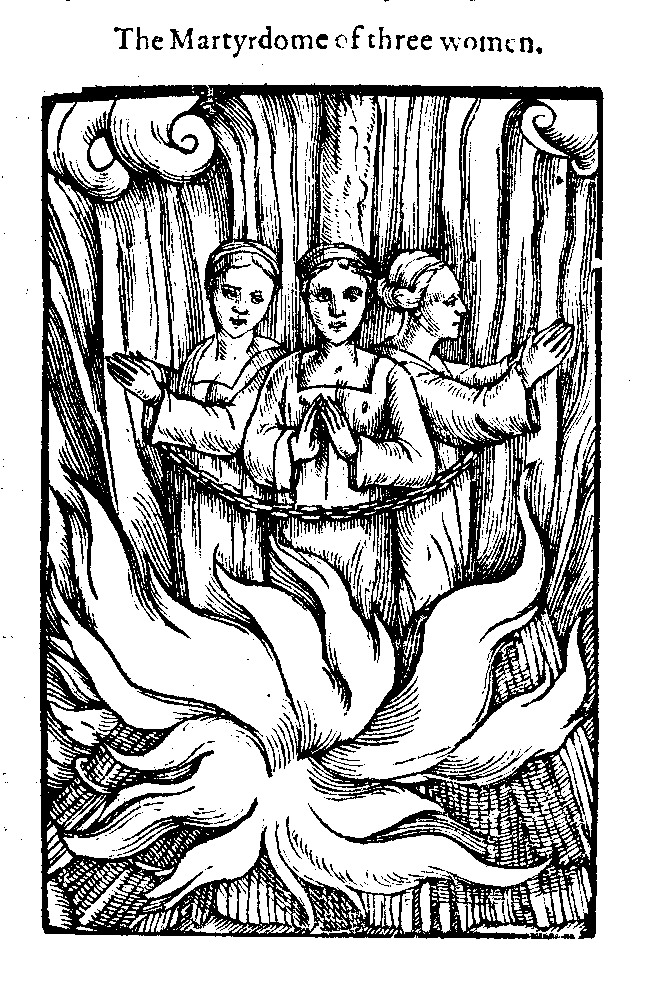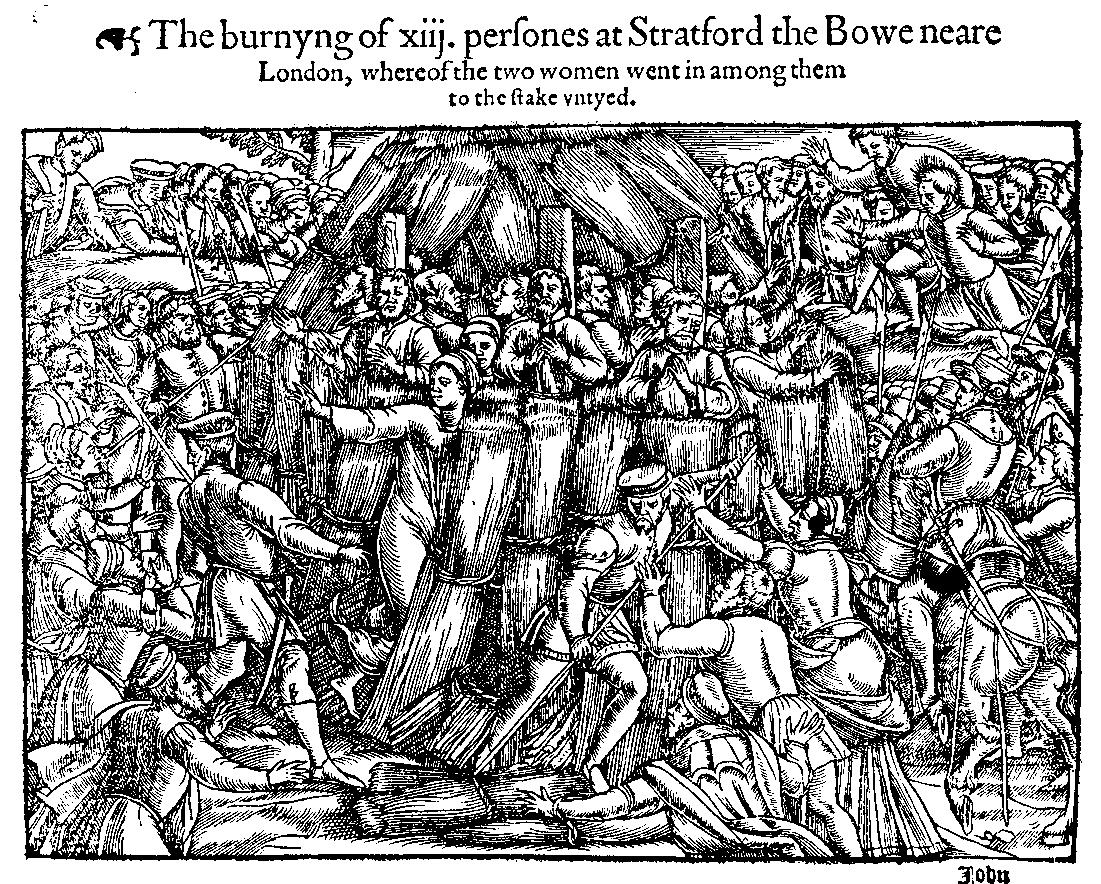Commentary on the TextCommentary on the GlossesCommentary on the WoodcutsLatin/Greek TranslationsCattley Pratt ReferencesThematic DivisionsTextual TranspositionsTextual VariationsGlossary of PeopleGlossary of PlacesEssaysBibliographyAbbreviations
The Burning of M. John Rogers, Vicar of S. Pulchers,...The burning of Mayster Laurence Saunders at Coventry.The description of the burning of Maister Iohn Hoper...The Martyrdome of Doctor Taylour, burned at Hadley,...The burning of Thomas Thompkins hand by Bishop Boner,...The Burning of the blessed Martyr, Thomas TomkynsThe burning of William Hunter MartyrThe cruell burning of John Laurence MartyrThe cruell burnyng of M. Farrar, MartyrThe burning of Raulins, MartyrThe Description of a Popish Priest, who when he had...The cruell burning of George Marsh, MartyrThe burning of William Flower at WestminsterThe Martyrdome of John Cardmaker, and John Warne, UpholsterThe Martirdome of Thomas Haukes in Essex, at a towne...The burning of Thomas Wattes, MartyrCertayne Bishops talking with Maister Bradford in prisonThe talke betwene M Bradford, and two Spanish FryersThe description of the burning of M John Bradford Preacher,...The burning of foure MartyrsThe Martyrdome of Margery PolleyThe Martyrdome of Diricke CarverThe Martyrdome of Thomas JuesonThe Martyrdome of Maister John DenleyThe burnyng of sixe godly martyrs in one fireA Picture describing the maner and place of them which...The martyrdome of William HalleThe picture describing the straight handling of the...The Cruel burning of Robert Samuel, MartyrThe burnyng of five Martyrs in CaunterburyThe burning of Mayster Robert Glover, and Cornelius...The burning of William Wolsey, and Robert Pygot, MartyrsA description of M. Latimer, preaching before K Edward...A table describing the burning of bishop Ridley and...The order and maner of burying in the fieldes such...Maister Philpot beyng in the Colehouse, where he found...The martirdome of maister John Philpot Archdeacon,...Seven godly and constant Martyrs, suffering at one...The burning of the foresayd man and foure womenThe description of Doctour Cranmer, howe he was plucked...The burnying of the Archbishop of Caunterbury Doctor...The burning of the foresayde sixe men at ColchesterThe Martyrdom of a blinde man, and a lame man, at Stratford...The Martyrdome of three womenThe burnyng of xiii. persones at Stratford the Bowe...Unheaded woodcut ['The Martyrdome of the three godly...A Lamentable Spectacle of three women, with a sely...
Commentary on the Woodcuts for Book 11
The Burning of M. John Rogers, Vicar of S. Pulchers, and Reader of Paules in London.
The woodcut of the burning of John Rogers at Smithfield gives the impression of an agitated scene, attended by a large crowd, some watching from nearby windows, as they were shown doing in other burnings in urban settings (e.g. William Flower at Westminster, the following year). The moment is the climax at which the dying man washed his hands in the flames 'as he was in burning', and around him men and women gesture and throw up their hands in what can only be read as gestures of acclamation. This was the first burning of Mary's reign, and apart from the horseman (apparently Sir Richard Southwell) armed men are singularly absent. The awkward placing of this print on the page in 1563, spilling over the columns of text, is indicative of the problems of layout faced in Foxe's first English edition with the introduction of large narrative woodcuts. The satisfactory solution reached in 1570, and; 1583, was abandoned in the cheaper 1576, edition in which this and the other large woodcuts extend into both margins. Rogers' last words were reset in each of the early editions; roman type 1563, to italic 1570, to roman again in 1576,and 1583, with minor spelling differences.
1563 Edition, page 1106 | 1570 Edition, page 1701 | 1576 Edition, page 1444 | 1583 Edition, page 1517[Back to Top]The burning of Mayster Laurence Saunders at Coventry.
Lawrence Saunders, burned in a park outside the city of Coventry, is depicted being chained to the stake which he had embraced and kissed as the cross of Christ. There are armed guards all round (their pikes punctuate the background), ready to restrain supportive onlookers like the man on the left. But the stony-faced man below Saunders on the right, given the ugly features of friars and persecutors in other illustrations, shows that not all present were of this cast. The victim's agony was increased (as John Hooper's was to be) by the green wood of the still unlit fire. Foxe could not resist the comparison with St Lawrence, who featured among the 'old martyrs of Christ's church', whose sufferings were portrayed in the large print of the ten first persecutions of the primitive church, first included in 1570. As in other cases the woodcut gives the martyr's last words even though showing him before the fire was kindled. In 1563, the banderole is blank, perhaps (as in the similar case of the seven Smithfield martyrs 1563, p. 1451) indicating doubts or lack of information on the blockmakers' part. This deficiency was made good in the copy now in Ohio State University Library, in which an early hand has inserted 'O lord resieve my soule'. The words added to the scroll in 1570, were 'Welcome life', in italic, thereafter recut in 1576, and 1583, respectively in roman and italic. The missing edge of the scroll is a tell-tale clue to these alterations.
1563 Edition, page 1117 | 1570 Edition, page 1709 | 1576 Edition, page 1451 | 1583 Edition, page 1523[Back to Top]The description of the burning of Maister Iohn Hoper Byshop of Glocester
In 1570: The burnying of Maister Iohn Hoper Byshop at Glocester The 'description' of Hooper's burning (as it was headed in 1563, when this term was used more often than in later editions) is a graphic transcription of the bishop's suffering in the fire that took so slowly, showing the arm that fell into the flames as he beat his breast. He is depicted frontally which is unusual, and focuses attention on the carefully delineated tension of his shoulders and almost sculpted, seemingly outsize head. Also unusually he is bound to the stake at chest as well as waist. The image is related to that in Foxe's Latin Rerum in ecclesia gestarum of 1559 (Pt I, p. 297) in which Hooper stands erect in a similar pose on the high stool that Foxe refers to, though here he is still clothed and intact, not yet affected by the blaze that surrounds him. Although the image in the continental edition (the dramatic plumes and curls of whose fire is unlike the imagery of the English work) might seem custom made for Hooper, it also served to illustrate Hus (Rerum, Pt II, p. 1). The layout in 1563 also echoes that of the earlier book, allowing a full page to the woodcut with lines of verse below. In both cases a single woman represents the sorrowing crowd, in the Acts and Monuments attracting the seemingly sympathetic attention of the official on her right. Changes to the speech scroll - gothic in 1563, italic 1570, roman 1576, and redone roman 1583, had resulted in damage to the framing line by 1570.
1563 Edition, page 1133 | 1570 Edition, page 1723 | 1576 Edition, page 1463 | 1583 Edition, page 1534[Back to Top]The Martyrdome of Doctor Taylour, burned at Hadley, for the testimony of the Gospell
The parish of Hadleigh in Suffolk, with its history of reforming support, lauded by Foxe as this 'universitie of the learned', was severely affected by the death of its rector, Rowland Taylor. The image is concentrated on this forceful martyr with his 'reverend and ancient face, with a long white beard' and shock of perhaps also white hair, which had been lopped when Bonner clipped it to give him a fool's head. The cutters of the woodblock doing justice to this head, framed by the readied faggots, have given it an almost haloed appearance. Although the fire is shown unlit Taylor is represented at the moment he uttered his last words, holding up both hands. John Nowell, who succeeded Taylor as rector of Hadleigh, preached there the day after Taylor's burning and tried to minimise the impact of his death, saying that 'to persevere is a develishe thynge ffor it moveth many mindes to see an heretyke constante and to dye'. While, as Foxe himself admitted in his first edition, the faithful in Hadleigh were cowed and many left after this event, Nowell's words seem to indicate that Taylor's stand in the fire, watched here by an impassive crowd, was itself brave and unflinching. The blank banderole below Taylor's, empty in all four editions, appears from its placing as if it was intended to contain words of the mounted sheriff, though the last official address to Taylor reported in the text came from Sir John Shelton 'there standing by.' Taylor's last words went from gothic type 1563, to italic 1570, to Roman 1576, and (with minor spelling difference) 1583.
1563 Edition, page 1149 | 1570 Edition, page 1742 | 1576 Edition, page 1480 | 1583 Edition, page 1551[Back to Top]The burning of Thomas Thompkins hand by Bishop Boner, who not long after burnt also his body
This illustration, which is one of those in the first edition that were too wide for the page format, spilling in the margin, is of interest in showing how Foxe's rewriting could undermine the accuracy of his illustrators in translating his words into visual form. The woodcut that accompanies this example of 'bloody' Bonner's remorseless cruelty both adds implied readings to Foxe's text and also ignores one detail, probably owing to additions Foxe was able to make to his text after the cutting of the woodblock. The setting is the hall of the bishop's palace at Fulham, whose character is conveyed by the fine chairs, swag of curtain and covered table. Bonner is labelled, though his fat features became recognisable in the course of the book. In 1570 and later editions, the passage preceding this act of trial by fire (ostensibly to win over the accused through fear of fire) included exchanges between Bonner and Tomkins that resulted in the bishop having Tomkins' beard shaved. The fact that he is depicted here with a beard is presumably due to the fact that Foxe discovered this anecdote too late to be incorporated in the text, and added it to an appendix in the 1563 edition. The actual burning carefully represents the text, showing the bishop holding the candle in his left hand while he pinions Tomkins fingers in the flame with his right. The attitude of the four clergy seems to suggest that it was not only Harpsfield (standing next Bonner) who had reservations about this action, when Tomkins' burnt hand spurted into his face. That was another detail which could not have been represented in 1563 since it was only included in the 1570 edition. At the other end of the table an arresting hand is raised, two heads confer together and the servant turns away. The change of heading to this illustration from 'The sharpe burnyng of Thomas Tomkyns hand, by cruel Boner hym selfe who not long after burnt also hys body' (1563) to 'The burning of Thomas Tomkins hand by Bishop Boner ' (1570) surely reflects some editorial decision rather than any change of heart on Foxe's part. Bonner died between the two editions, on 5 September 1569.
1563 Edition, page 1170 | 1570 Edition, page 1749 | 1576 Edition, page 1486 | 1583 Edition, page 1558[Back to Top]The Burning of the blessed Martyr, Thomas Tomkyns
One of the frequently recycled single column woodcuts, this is unusual in being combined here with a large woodcut of the same martyr. This cut (Type 1) was reused three times in the last two books of 1583, pp. 2022, 2034, 2053. See also 1570, p. 2124, 2246; and 1576, p. 1940.
1570 Edition, page 1751 | 1576 Edition, page 1487 | 1583 Edition, page 1559[Back to Top]The burning of William Hunter Martyr
This example of the small woodcuts added in 1570 (Type 2) is among those that were not put to repeated use. Allowance should be made for the possibility (as with the small cut (d) of Raulins White) that this woodcut was tailored to Foxe's account of the martyr, in this case the teenage apprentice who lifted up his hands to heaven immediately before he died.
1570 Edition, page 1755 | 1576 Edition, page 1491 | 1583 Edition, page 1562[Back to Top]The cruell burning of John Laurence Martyr
Among the smaller woodcuts made to illustrate an individual case, this is unusual in two respects: in showing a group of children, whose presence allowed Foxe to moralise for the benefit of two generations, and in the iron chair to which the priest was chained. There was early church precedent for such martyrdom, and a woodcut of Attalus (one of a group martyred in 177) in the flames in an iron chair was printed in Ludwig Rabus, Historia der Heyligen (1556-58), while Foxe's large table of the ten first persecutions of the primitive church delineated Maturus and Sanctus (two others of the martyrs of 177) being 'fried in an iron chair'. Anne Askew [Ascue], her body racked by torture, was carried to the stake and burned sitting in a wooden chair, though this did not feature in the illustration of her martyrdom. For the burning of Anne Askew, which first appeared in Robert Crowley, The confutation of xiii articles (1548), see 1563, p. 666; 1570, p. 1420; 1576, p. 1210; 1583, p. 1240.
1570 Edition, page 1760 | 1576 Edition, page 1496 | 1583 Edition, page 1567[Back to Top]The cruell burnyng of M. Farrar, Martyr
The woodcut illustrating Bishop Farrar's death was changed in 1570 for a block very different from that used in 1563. This earlier image belonged to the group of burnings with very distinct characteristics (skeletal bodies with flames invading them) whose dimensions were difficult to accommodate on the page. Like others of its kind in the first edition (eg William Sawtry, 1563, p. 142) the cut spread into the gutter and the left column of text. This awkwardness doubtless dictated its replacement. The replacement of 1570 came from Reginaldus Gonsalvius Montanus, De heylighe spaensche inquisitie (John Day, 1569), sig. x7v, and thereafter the block (identifiable from the chip on its top left corner) saw multiple use. In 1570, it was repeated seven times, and in 1583, it stood for eight martyrs besides Farrar, between the years 1436 and 1555 (1583, pp. 668, 701, 815, 998, 1030, 1040, 1275, 1682). Further chips on the lower edge in 1576 and 1583 bear witness to this extensive reuse. This woodcut of a martyr chained in flames is typical of many of the Marian martyrs illustrated in 1570, and thereafter, and this example suggests that difficulties of layout may have prompted Day to start working towards a new series, tailored to the page, not long after the appearance of the first edition. (See 1563, pp. 1548-49 (mispagination - pp. 1548-49). This woodcut (Type 1) with its distinctive flares and ionic scrolls of flames belongs to a recognisable family of these small martyr images, but their designers and cutters have not been identified. It may be noted that the speech scroll in 1563, is in italic, unlike that of the companion block in 1563, p. 1603 (the burning of a Norwich man and woman), which is in roman.
1570 Edition, page 1763 | 1576 Edition, page 1498 | 1583 Edition, page 1579[Back to Top]The burning of Raulins, Martyr
The illustration of the bearded dignified figure of Rawlins White, one of the small woodcuts (Type 2) added to the 1570 edition, was among the group of these well-worked blocks which was not reused. Although Foxe's account provided sufficient drama for a specific illustration, this seemingly generalised image was perhaps following the text in showing Rawlins, the 'good old man' (aged about 60), his back 'close to the stake', bearded and bolt upright.
1570 Edition, page 1767 | 1576 Edition, page 1502 | 1583 Edition, page 1583[Back to Top]The Description of a Popish Priest, who when he had taken away the glory and office of Christ, fell downe sodenly, and dyed
Like the burning of John Lawrence (1583, p. 1543) this image belongs to the small group of single-column cuts that were narrative and specific. The exemplary image of the popish priest of 'Crondall' (i.e. Crundale, Kent, in the diocese of Canterbury) illustrates the punishment that was visited on the preacher for applying words of St John to his papal bull of pardon. The depiction implies passive inertia on the part of the congregation who heard this message, rosaries in hand. But the church in which they sit has the features of a reformed building. Here and elsewhere (compare the burning of Tomkins' hand) the illustrators depict white glass with distinctive oval quarries, and in this case the plain windows, together with the pulpit, represent a properly reformed church. In fact St Mary's, Crundale, still has some fragments of its medieval stained glass.
1570 Edition, page 1770 | 1576 Edition, page 1504 | 1583 Edition, page 1585[Back to Top]The cruell burning of George Marsh, Martyr
The martyrdom of George Marsh (Type 1 of the small woodcuts) perhaps earned illustration by virtue of the unusual presence of the firkin containing pitch and tar attached to the stake. It is shown dripping onto the martyr's head as he stood enduring the additional suffering of a poorly made fire that burned uncertainly.
1570 Edition, page 1777 | 1576 Edition, page 1510 | 1583 Edition, page 1591[Back to Top]The burning of William Flower at Westminster
The illustration of William Flower, among those that show the moment just before the pyre was lit, portrays the horrific detail of the martyr praying after his right hand, impaled on a pike, was cut off as he stood at the stake. The witnesses present who 'credibly informed' the martyrologist about this are not shown. The circle standing round the stake (with some indication of the density of the urban setting) seems to consist only of ecclesiastical and secular officials - apart from two heads looking out of a window in the distance. The banderole containing Flower's last words retained its framing line intact until 1583, when the text (still in the roman lettering it had in all four editions) was reset.
1563 Edition, page 1203 | 1570 Edition, page 1788 | 1576 Edition, page 1520 | 1583 Edition, page 1601[Back to Top]The Martyrdome of John Cardmaker, and John Warne, Upholster
In a faithful transcription of Foxe's text, the woodcut shows John Cardmaker talking to 'the sheriffs', with John Warne already bound to the stake. The admonition in his banderole (recut, changing 'idolatry' to 'idolatrie' in 1576) is the equivalent of a sermon text: 'Wherefore, my dearly beloved, flee from idolatry', 1 Cor. 10:14). The crowd, anxious lest Cardmaker might make a last minute recantation, is focused on Warne's words, while the pointing official on the right seems to indicate that the decision still hung in the balance. The woodcut suggests the difference in age between Warne, aged 29, and Cardmaker, who had been a friar before the Dissolution.
1563 Edition, page 1209 | 1570 Edition, page 1791 | 1576 Edition, page 1522 | 1583 Edition, page 1604[Back to Top]The Martirdome of Thomas Haukes in Essex, at a towne called Coxehall
The young, 'comely' and well-informed Essex gentleman, Thomas Haukes, called an exemplary 'bright starre' by the martyrologist, having been examined and condemned in London, was committed to Lord Rich and returned to Essex for execution at Coggeshall. There friends and acquaintance came to his burning, shown in this crowded scene hemmed in by armed guards. They asked for a signal to show that the spirit could remain constant in the fire, and Haukes is depicted giving this, lifting his hands over his head and clapping them as he gave his last. His last words, given in italic letters in 1563, were renewed in roman with slight differences in each of the succeeding three editions. The slopes and trees and village church in the background quite deftly suggest the country location. The style of the central portion of the woodcut, with its straight lines of stacked wood and flames that snake around the martyr, bear some similarity to the small group of single-column cuts that appear to have been borrowed from another (unidentified) source (see Introduction).
1563 Edition, page 1230 | 1570 Edition, page 1806 | 1576 Edition, page 1535 | 1583 Edition, page 1616[Back to Top]The burning of Thomas Wattes, Martyr
This is one of the small cuts introduced in 1570, which saw repeated use. It was reused four more times after this appearance in, 1583, at pages 1683, 1704, 2021, 2045, and is one of the two small woodcuts (see also small cut [i]) that, unlike the majority, show martyrs in an unlit pyre with pikemen in the background. The curious lack of the top framing line in this instance, indicating that the block was shortened, also suggests this was some kind of exception in the series.
1570 Edition, page 1810 | 1576 Edition, page 1539 | 1583 Edition, page 1620[Back to Top]Certayne Bishops talking with Maister Bradford in prison
The importance of John Bradford and his inspiring letters for Foxe's history is reflected in his being allotted three large narrative illustrations (more than any other individual). The picture of Archbishop Heath of York and Bishop Day of Chichester visiting Bradford in the Counter in an attempt to move his mind shows them in his prison cell using the formal gestures of disputation. The barred windows of the small room and the keeper's keys hanging from his wrist tell of Bradford's confinement, though he is not bareheaded in this lordly presence, nor are the visitors seated, thanks (as the text explains) to the bishops' special courtesy. Inscriptions help readers' identification of the prison keeper and Bradford.
1563 Edition, page 1274 | 1570 Edition, page 1833 | 1576 Edition, page 1558 | 1583 Edition, page 1639[Back to Top]The talke betwene M Bradford, and two Spanish Fryers
The pressure of persuasion to which Bradford was subjected in the Counter included, soon after the efforts of the prelates, the weight of the mendicants. They are represented in the way that was customary in the Acts and Monuments as sinister figures whose ugly features betray their evil scheming character. As in the preceding picture of Bradford, barred window and gaol keeper set the scene, and again the leading figures are named. But the atmosphere is very different from the civilised exchanges with the bishops. Bradford is seated, but he is being intimidated and with fixed gaze clings to his book. The gaolor stands threateningly at his side while the ample figure of the ruthless Alphonso lunges towards him, abetted by the hooded figure of King Philip's confessor. The threatening group on the right, specially the sinister central figure, raising his left hand to his cap, seems to be echoed in the two enemies of Gods word pulling a preacher from the puplit, who illustrate 'Envie' in Stephen Bateman's A christall glasse (London, 1569), sig. G4r (a woodcut which seems also to reflect Foxe's woodcut of Thomas Bilney being pulled out of the pulpit). The narrow eyes and broad noses of this popish posse could have been modelled on the features of cruelty as described in the work of physiognomy printed by John Day in 1558.
1563 Edition, page 1278 | 1570 Edition, page 1836 | 1576 Edition, page 1561 | 1583 Edition, page 1642[Back to Top]The description of the burning of M John Bradford Preacher, and John Leafe a Prentice
Bradford, standing in the pyre on the right with his call to England to repent of idolatry, and the short figure on the left of the illiterate young apprentice, John Leafe, who died with him, are shown before the lighting of the fire. The preliminaries reflected the godly fibre of the accused as they first prayed prostrate beside the stake, and then Bradford kissed the instruments of his coming death and gave his clothes to his servant. Apart from one pair of raised hands, officials and guards armed with pikes dominate the scene. Sheriff Woodroffe, who abruptly silenced Bradford's invocation and ordered his hands to be tied, was divinely punished by being struck down with paralysis six months after this event. As other martyrdoms show, hands were the last remaining recourse for communication from the fire. This is not the only case (compare Laurence Saunders, or Latimer and Ridley) in which the illustrator takes temporal liberties, representing an unlit pyre as well as the martyr's last words uttered in the flames. And as elsewhere, the final words were set afresh in each edition gothic type (1563), roman thereafter but with minor differences in positioning.
1563 Edition, page 1285 | 1570 Edition, page 1844 | 1576 Edition, page 1567 | 1583 Edition, page 1648[Back to Top]The burning of foure Martyrs
The small woodcut of two men in flames (Type 2) was drafted in here to illustrate the burning of four men, for which the producers had no block. This woodcut saw repeated service and in 1583 appeared again on pages 1716, 1940 (representing three martyrs) and page 2052. Unusually the two men in the pyre are shown wearing loin cloths.
1570 Edition, page 1895 | 1576 Edition, page 1614 | 1583 Edition, page 1700[Back to Top]The Martyrdome of Margery Polley
The small woodcut of Margery Polley (Type 2), placed in the text where Foxe promises a fuller account to come, is the first to show a single women in the flames. It was not reused on two subsequent occasions when such a martyr was illustrated (Cicelie Ormes and the woman of Exeter).
1570 Edition, page 1899 | 1576 Edition, page 1618 | 1583 Edition, page 1703[Back to Top]The Martyrdome of Diricke Carver
The image previously used for Farrar's burning.
1570 Edition, page 1901 | 1576 Edition, page 1620 | 1583 Edition, page 1706[Back to Top]The Martyrdome of Thomas Jueson
The repeating image previously used for Thomas Wattes' burning.
1570 Edition, page 1902 | 1576 Edition, page 1621 | 1583 Edition, page 1707[Back to Top]The Martyrdome of Maister John Denley
The image of Denley is as much about the executioners as the martyr. It belongs to Type 1 of the small woodcuts, and the emphasised plume of smoke characteristic of these cuts serves to form a kind of barrier between martyr and persecutors. The illustration shows the moment at which the faggot is hurled in Denley's face on the order of 'cruel Dr Story', whose profile and pointing hand reflect this repute, while the inscription of his name in the background ensures the identification. Denley's patient endurance is evident in his stance.
1570 Edition, page 1906 | 1576 Edition, page 1624 | 1583 Edition, page 1709[Back to Top]The burnyng of sixe godly martyrs in one fire
The image of six men in one pyre (Type 1), the first small woodcut of a group burning, was to be put to repeated use - not always for this number (see 1583, p. 2039, the seven Smithfield martyrs). This was a block that had been used earlier (backing the title page) in John Day's 1564 edition of Certain most godly, fruitful, and comfortable letters of such true Saintes and holy Martyrs (STC 5886).
1570 Edition, page 1907 | 1576 Edition, page 1625 | 1583 Edition, page 1712[Back to Top]A Picture describing the maner and place of them which were in bondes for the testimony of the truth, conferring together among themselves
This group of Bonner's prisoners, thanks to the leadership of the fervent Robert Smith, who had proved himself through several fully reported examinations by the bishop, was able to derive comfort from conferring and praying together under his direction. They are shown behind bars in 'an outward house' of Newgate prison, furnished with bench, cups, stools and, more importantly, with the benefit of books. This facilitated 'public reading' led by Smith who is clearly holding this session with direct reference to the text in front of him. Four of the prisoners are identified with names ('R Smith', 'Tankerf.', 'Simpson.' and 'I. Newman') incorrectly cut on the block, which remained in this mirror form through the first four editions, unlike the following linked example of prisoners in the Lollards' Tower (1563, p. 1272; 1583, p. 1703) which was corrected in 1583.
1563 Edition, page 1329 | 1570 Edition, page 1914 | 1576 Edition, page 1631 | 1583 Edition, page 1719[Back to Top]The martyrdome of William Halle
This small cut is one of the two single-column blocks (that of Thomas Wattes, small cut [e] is the other) that show a martyr in an unlit pyre and with the pikes of armed men in the background. It too was repeated, though only once in the last two books of 1583, at page 2047. It already had a chip in its frame in 1570.
1570 Edition, page 1916 | 1576 Edition, page 1634 | 1583 Edition, page 1726[Back to Top]The picture describing the straight handling of the cloase prisonners in Lollardes' Tower
In conjoining two adjacent reports in the text, this woodcut appears (unusually) to misrepresent Foxe's account, by showing prisoners from two different prisons confined in one place. In 1570 Foxe changed his first report of the prisoners' locations, but the story still involved two prisons. The three men shown seated in the stocks (finally identifed as Thomas Leyes, John Wade and George King), part of the group of ten accused, some of whom featured in the illustration a few pages earlier, were indeed reported as awaiting trial by Bonner in the Lollards' Tower (the southern of the two western towers of old St Paul's Cathedral). There they became so ill that they were confined to houses in the city where they died. William Andrewe however, an Essex carpenter who had been sent up to the council by Sir Richard Rich, was imprisoned in Newgate after examination by Bonner. Depicted here collapsed on the straw, seemingly as broken as the pitcher beside him (his condition attributed in the text to 'straite handlynge' in prison) he died m Newgate. The author's verification of his stories is reflected in the changes of the prisoners' names. In 1563, the central figure in the stocks was labelled 'Ri. Smith', but in 1570 and thereafter, probably because of doubts about his reported death in prison, Smith was replaced by the correct name of John Wade. George King was named Thomas in 1563, corrected to George in 1570. The typeface label for Andrewe, originally set upside down as 'Androws' (1563) and then 'Andrew' (1570), was only placed the right way up in the block in 1583. This illustration therefore shows the endeavour to provide accuracy, as reflected in the changes to the names, combined with the pictorial licence of representing in one prison individuals who were incarcerated in different places. However, the latter procedure may be seen as analogous to the temporal elisions that appear elsewhere (with separate episodes of one narrative being set in a single picture frame), itself an old and accepted device of pictorial narrative. A comparable picture of prison stocks appears in the scene of 'Maister Philpots beyng in the Colehouse'.
1563 Edition, page 1341 | 1570 Edition, page 1917 | 1576 Edition, page 1634 | 1583 Edition, page 1727[Back to Top]The Cruel burning of Robert Samuel, Martyr
A repeat of the image used for Thomas Wattes.
1570 Edition, page 1919 | 1576 Edition, page 1636 | 1583 Edition, page 1728[Back to Top]The burnyng of five Martyrs in Caunterbury
The small woodcut of five men, burned in September 1555 at two stakes in one fire at Canterbury (Type 1), was reused for two subsequent multiple burnings, including that of three men and two women at Canterbury in November 1558.
1570 Edition, page 1923 | 1576 Edition, page 1640 | 1583 Edition, page 1732[Back to Top]The burning of Mayster Robert Glover, and Cornelius Bongey at Coventry
This image (Type 2) has a close family resemblance to the small cut (f) of two men chained to one stake, though here they are clothed in the usual simple garments, and face each other in an embrace of Christian amity.
1570 Edition, page 1930 | 1576 Edition, page 1646 | 1583 Edition, page 1738[Back to Top]The burning of William Wolsey, and Robert Pygot, Martyrs
1570 Edition, page 1933 | 1576 Edition, page 1648 | 1583 Edition, page 1740[Back to Top]A description of M. Latimer, preaching before K Edward the 6 in the preaching place at Westminster
The woodcut of Latimer preaching before Edward VI had been used in John Day's 1562 edition of 27 sermons preached by the ryght reverende ... maister Hugh Latimer. (STC 15276) as a foldout in pt 1, after sig. D6. It was a misfit for a quarto volume, and when reused in 1571 in Day's Frutefull sermons, (STC 15277), was uncomfortably set sideways on f.22v, with its heading truncated and the image disappearing into the gutter. Possibly the block, which was the same size as the other large woodcuts in Foxe's work, was designed with that series in mind. The illustration of the outdoor pulpit constructed late in Henry VIII's reign in the Privy Garden of Whitehall is important as giving a clear and seemingly fairly accurate picture of this innovatory preaching centre. This outdoor pulpit erected in the heart of court life in the capital, with a capacity to accommodate a standing congregation of thousands (infinitely larger than that of the chapel royal), also provided for court attendance in an upper gallery or terrace and (under cover) in the council chamber that ran along one side. Edward VI appears at the open window of this projecting casement (for which new glass was provided in 1549) with three courtiers (possibly the foremost bearded figure represents the Duke of Somerset) on his right. Latimer, leaning, book in hand, on the carpeted side of the pulpit which was constructed at the centre of the courtyard and ornamented in the most à la mode renaissance style, is speaking directly to the royal group. Only two women can be made out in this vast throng: the seated woman with book on the pulpit step (something of a symbolic figure) and another standing among the select group in the pulpit, behind the listener who rests on his elbow. The accepted importance of preaching was recognized in a new way in this royal Sermon Court, which, unlike the celebrated pulpit at St Paul's and other old outdoor pulpits across the land, had no association with consecrated ground and burial of the dead. As one of the few illustrations in the Book of Martyrs that was not devoted to martyrs and their sufferings, this woodcut tells us as much about the role of preaching as that of Henry VIII suppressing the pope does about the biblical word. The labels for 'K. Edward' and 'M. Latimer', in italic in 1563 and 1570, were redone (still in italic) in 1576 and again (now in roman, with 'Mayster Latimer') in 1583.
1563 Edition, page 1422 | 1570 Edition, page 1947 | 1576 Edition, page 1661 | 1583 Edition, page 1763[Back to Top]A table describing the burning of bishop Ridley and father Latimer at Oxford, D. Smith there preaching at the time of their suffering martirdome.
Depicting one of the most celebrated events in the Acts and Monuments, the large woodcut of the two Oxford martyrs managed to produce quite a monumental effect by means that might have seemed simplistic or naive to continental print-makers. The effect of a bird's eye view is achieved by tilting the plane on which the pyre is set, as if we were looking down from the vantage point of a hill. The huge crowd is suggested by the time-honoured method - followed here with tireless repetition - of portraying innumerable heads as featureless as peeled potatoes. Actual individuals appear at the edges of this human ring, with the usual band of pikemen, manning the front of the circle, ready to ward off any who step out of line. At the back, on the front edge of the picture, people place comforting arms on other's shoulders; one man with raised arm signals to the martyrs over the rows of people before him. As the speech scrolls make clear, the illustrator has condensed several moments of the final drama, both before the fire was lit and also after it had started. The three officials in charge of the pyre are still handling the last bundles of faggots, and have ready a small blaze to kindle the pile. Thomas Cranmer, fully bearded as we know him in posthumous portraits, looks down from the tower of his prison, the Bocardo, over the north gate of the Oxford city wall, praying God to strengthen his two friends. Ridley had looked up as he passed the prison, hoping to see the archbishop there, but Cranmer at this moment was occupied in disputation with Pedro de Soto, the Spanish Dominican. He was brought to witness the burning, as a fearful deterrent, and was present to hear Richard Smith's fifteen minute sermon on 1 Cor. 13:3 ('If I give my body to be burned ...' - the text given in Latin in his banderole), delivered from an imposingly high portable pulpit. At the side the four commissioners headed by John Williams, Lord Thame (labelled) are seated on a form as described in the text. Williams, holding the scroll which presumably bears the judgement against the accused, has a banderole that records his response to Ridley's final request on behalf of his sister and several poor men. The words scrolling from the mouths of the two martyrs, the ancient Latimer and the much younger virile Ridley, were as usual their final utterances delivered as the flames reached up towards them. The famous words, first attributed to Latimer in the 1570 edition ('we shall this day light such a candle ...') possibly apocryphal but so well remembered, show that the authentic last utterances, scriptural and otherwise, over which the editors and illustrators took such pains, were not necessarily those that most moved Foxe's readers. Here as elsewhere, there were changes in the form of the final words in the different editions. Latimer's 'Father of heaven ...' in gothic script in 1563, and 1570, (reformatted) was in roman in 1583; Ridley's words were in Latin roman script ('In man[us] tuas domine') in 1563, then English (gothic) in 1570, and back to Latin (now roman) in 1583. The large woodcut exemplifies the printer's dilemma about how best to incorporate illustrations that would not fit onto the page. In this case two treatments were adopted. First (1563) tipping in, which necessitated folding the print; then (1570) binding the woodcut (facing sideways) into the book, with continuation of the text printed on its back; and then in 1576 and 1583 a return to tipping in. Neither expedient could deter removal of the picture, though this was obviously more of a temptation with the tipped in versions, which survive in some copies torn out and floating loose between the pages.
1570 Edition, page 1977[Back to Top]The order and maner of burying in the fieldes such as died in prisons.
Alternative title: 1583: The order and maner of burying in the Fields such as dyed in prison, and namely, of William Wiseman. The fate of the London clothworker, William Wiseman, who died in the bishop of London's prison, the so-called Lollards' Tower of St Paul's, was not unique. Another woodcut (1583, p. 1703), told the story of four prisoners who earlier in 1555 had similarly been 'cast into the fields' after dying in custody. As was here explained with caustic irony, the 'devout manner' customary in church law prevented suicides and heretics whose alienation placed them beyond God's mercy from being granted burial in consecrated ground. The scene shows the charitable action of a group of devout 'good Tobies', who put themselves at risk by giving decent burial to the outcast under cover of darkness. The reference is to the example of Tobit in the apocryphal book of Tobit (included in the Geneva Bible), who made a grave and buried a man who had been strangled and cast out in the market place. A sizable throng is depicted, including the archers mentioned as being out in the fields, one of whom looks heavenward, doffing his cap. This was a religious ceremony, with psalm-singing and women with praying hands, as Wiseman was gently laid to rest. In 1563 the woodcut has no top framing line - giving the appearance of its having been removed to make room for the heading. In 1570 this is made good by a thin replacement line of the kind used to surround the columns of text. In 1576 and 1583 the line is again lacking.
1563 Edition, page 1456 | 1570 Edition, page 1999 | 1576 Edition, page 1713 | 1583 Edition, page 1819[Back to Top]Maister Philpot beyng in the Colehouse, where he found Thomas Whittle Priest, sittyng in the Stockes.
John Philpot (whose importance earned him two illustrations in Foxe's work), is here shown imprisoned in the most degrading of places. When told by Dr Story, Bonner's chancellor (for whom a heretic could have no claim to gentle status) that he was to be sent to the Lollards' Tower or the bishop of London's coalhouse, he protested that this would be vile even for a dog. The remark is echoed in the woodcut which shows a cur of a dog, accompanying Master William Roper, one of the prisoner's examiners, at work on the cell floor with a bone. But Philpot chose not to intermit his suffering by accepting the offer of a bed for one night in the gaol-keeper's house in Paternoster Row. He was taken to 'a little blind house' adjoining the ill-famed coalhouse, which, he recorded, was furnished with stocks for both hands and feet (as shown) and (not mentioned but illustrated) great chains attached to the walls. Thomas Whittle (the Essex minister whose full story follows later) whom Philpot found there with a poor man is shown in the stocks, though the text does not say as much. This seems to be an extrapolation from Philpot's statement that 'some before us had tried them [the stocks]'. One of his letters was 'written in a coal-house of darkness out of a pair of stocks'. The term 'blind house' implies a windowless building, and Philpot called it 'a dark comfortless place'. Darkness prevails in the woodcut, despite the single embrasure which casts shafts of light on those in the small cell.
1563 Edition, page 1487 | 1570 Edition, page 2002 | 1576 Edition, page 1716 | 1583 Edition, page 1821[Back to Top]The martirdome of maister John Philpot Archdeacon, with the manner of his kneeling, and praying at the stake.
The picture of Philpot's martyrdom stresses the Christ-like analogies of his prayers at the place of execution. Smithfield is saluted by the kneeling victim who went on to kiss the stake as analogous to the cross. He said three psalms and distributed money to the responsible officers. The man of letters is shown in a calm scene of prayer that preceded his fiery end, a moment that is reflected in the stillness of the standing spectators, two of whom are men earnestly praying with joined hands. The short description of the death is followed by a godly prayer to be said at the time of martyrdom, and in 1563 the woodcut headed 'The description of Mayster Philpot, knelyng and praying at the stake' was placed next the text of this 'prayer to be sayde at the stake'. Philpot's words in the banderole (in italic in 1563, thereafter in Roman) were renewed in each of the subsequent three editions.
1563 Edition, page 1517 | 1570 Edition, page 2040 | 1576 Edition, page 1749 | 1583 Edition, page 1854[Back to Top]Seven godly and constant Martyrs, suffering at one fire together in Smithfield
Although the full width of a large woodcut was given to the seven martyrs burned together at Smithfield, unlike the small cut of the Canterbury seven (1583, p.1981, portraying six martyrs) things went wrong here too. The print seems to show four women and three men instead of five men and two women. This perhaps explains the lacking label for John Tudson, while John Went's name is attached to a female figure. In 1563 the labels were all blank, perhaps reflecting the difficulties over these discrepancies. Thereafter the names remained the same, being given in italic in 1570, and in roman in 1576, and 1583 - when they were reset with small differences of placing. The allocation of a large illustration for this group may be accounted for by the space given in Foxe's text to the writings as well as sufferings of Thomas Whittle and Bartlet Green. The mistake in the figures represented raises questions about the co-ordination between Foxe, Day and the illustrators, and the possible gap between care over tailor-made narrative prints and some generalised blocks of multiple burnings. Was this kind of error deemed unimportant or unlikely to be noticed?
1563 Edition, page 1520 | 1570 Edition, page 2070 | 1576 Edition, page 1777 | 1583 Edition, page 1882[Back to Top]The burning of the foresayd man and foure women
This small illustration of a multiple burning (Type 1), accurate in its representation of the five burned at two stakes in one fire (perhaps in the act of singing psalms together) stereotyped though it may seem in the repeating imagery of the small cuts, could have been tailored to this event. And it was not reused.
1570 Edition, page 2071 | 1576 Edition, page 1778 | 1583 Edition, page 1883[Back to Top]The description of Doctour Cranmer, howe he was plucked downe from the stage, by Friers and Papists, for the true Confession of hys Faith
The two images of Thomas Cranmer on adjacent pages gain added weight in 1563 by appearing together on one opening. Besides giving visual emphasis to Cranmer's ultimate steadfastness, both harp on the factious testing by Spanish friars with their exaggerated fulsome habits and cowls - themselves indications of popish excess. In both woodcuts the balding archbishop has the drooping moustache and long slightly forked beard characteristic of the Protestant patriarch, familiar from surviving portraits like that at Lambeth Palace (whose closeness to the features here indicates that even if posthumous it has good claim to authenticity). Cranmer is shown as having aged since 1534, as well as gaining a longer beard. Compare his face in 'The Pope suppressed by K Henry the eight' (1583, p. 799). The scene represents the utter dismay when Cranmer announced his renunciation of his recantation. Dr Henry Cole expresses astonishment in the pulpit where he had just delivered his sermon justifying the archbishop's burning. Cranmer, whose raised hands suggest the finality of 'it is finished', is pulled off the platform erected for his examination as commotion ensued and he was hurried off to the stake. The action, which takes place in a church interior that does duty for the gothic St Mary's, Oxford, shares features with the earlier illustration 1563, [(page un-numbered by Foxe (p. 474)] of Thomas Bilney being pulled out of the pulpit by two friars. That in turn was followed by another woodcut in John Day's 1569 A christall glasse (depicting 'Envy') that shows a friar pulling a preacher out of his pulpit by his beard, while the fire awaits him outside.
1563 Edition, page 1571 | 1570 Edition, page 2104 | 1576 Edition, page 1807 | 1583 Edition, page 1911[Back to Top]The burnying of the Archbishop of Caunterbury Doctor Thomas Cranmer, in the Towneditch at Oxforde, with his hand first thrust into the fire, wherewith he subscribed before.
The famous scene of Cranmer sacrificing as first oblation to the flames the right hand that had betrayed his heart became one of the best known passages in Foxe's book. The place where 'the holy bishops' Latimer and Ridley had burned is shown much as it was in the woodcut of that earlier event (1583, pp. 1769-70), with the tower over the north gate of Oxford's city wall, from which Cranmer had looked down. His 'long and thick' beard which gave his face 'marvellous gravity' is intact, as is his raised left hand, crumpling in the flames on his stiff horizontal arm. Everything is focused on this guilty index finger, exactly centred in the mid-point of the block - the gesture crudely paralleled by the outstretched left arm of the ugly Spanish friar John, still testing Cranmer's steadfast purpose. Cranmer's burning was one of the four woodcuts of English martyrs illustrated in Foxe's 1559 Latin book, but very differently. There the archbishop, bearded and erect, is still untouched by the roaring fire (tended, as in the Acts and Monuments by a solitary attendant) in which he holds his hand. In 1559 the assembled viewers are in the background, mainly officials. There is no crush of awed spectators filling the space as in the English book, and no banderole for the final words, 'Lord receive my spirit'. As in other cases, the chief persecutor is drawn to the viewer's attention by a label (in roman letters in both 1563 and 1570 - redone - and then in italic in 1576 and 1583. The archbishop's last words were naturally treated with care, the roman lettering of 1563 changing to italic in 1570 and then altered again respectively to roman and italic in 1576 and 1583
1563 Edition, page 1572 | 1570 Edition, page 2106 | 1576 Edition, page 1808 | 1583 Edition, page 1912[Back to Top]The burning of the foresayde sixe men at Colchester
Reuse of the illustration that had served the six of Canterbury in 1555.
1570 Edition, page 2129 | 1576 Edition, page 1829 | 1583 Edition, page 1933[Back to Top]The Martyrdom of a blinde man, and a lame man, at Stratford the Bowe
One of the small group of individualized small woodcuts, this image (Type 1) adapts the conventional form adopted for two men in the flames to illustrate the exceptional circumstances of burning a cripple and a blind man. The image conveys John ap Price's blindness with half-closed eyes, while Hugh Laverock is in shown in the act of throwing away his crutches.
1570 Edition, page 2129 | 1576 Edition, page 1830 | 1583 Edition, page 1934[Back to Top]The Martyrdome of three women
The woodcut (Type 1) seems to portray the description of the three young women dying 'joyfully in the flaming fire'. The image was not reused.
1570 Edition, page 2131 | 1576 Edition, page 1831 | 1583 Edition, page 1935[Back to Top]The burnyng of xiii. persones at Stratford the Bowe neare London, whereof the two women went in among them to the stake untyed.
The largest multiple burning to be depicted was of a group of individuals nearly all of whom came from Essex, the county preeminent for its godliness in Foxe's estimation. The thirteen are accurately represented, with the men in groups of four and three bound to the three stakes, and the two women shown unattached as described. It is an unusually animated scene, which the tree and embanked enclosure indicate as taking place in a rural setting. At the back and sides people peer over the surrounding bank and two men on the right seem about to throw themselves towards the outstretched hands of those already chained to the stake, surrounded by the towering pile of faggots. In front the two women joining the men are saying last farewells in the face of the pikeman. There is a sense of hubbub, with the onlookers of both sexes praying and reaching towards the unlit pyre. The two married women, aged 26 and about 30 (the latter reportedly pregnant) are shown making their way into the pile of faggots, seemingly an extrapolation from the statement that when the men were bound to the stakes they were 'loose in the midst without any stake'. The illustrator seems to have tried to show something of the age differential of the group (three of whom were 50 and the rest in their twenties or thirties): the face of the man praying (front right, above attendant putting on fuel) is distinctly lined and careworn as compared with those behind him.
1563 Edition, page 1593 | 1570 Edition, page 2135 | 1576 Edition, page 1835 | 1583 Edition, page 1939[Back to Top]Unheaded woodcut ['The Martyrdome of the three godly Saintes' in adjacent margin.]
A confusing reuse of a woodcut which has no heading and does not tally with the sidenote. It is placed in the account of Julins Palmer who is illustrated with another reused cut in 1570, p. 2124 (see below). The burnyng of Iulius Palmer, Martyr at Newbury Small cut (a) 1570, p. 2124. Julius, or Julins Palmer (Foxe used variants of his name) was only illustrated in 1570, and then with a small cut of repeating use (see Thomas Tomkyns). Julius Palmer was a fellow of Magdalen College, Oxford, which made his case of special interest to Foxe, who gained additional information about Palmer after his initial entry. These facts might have had some bearing on the illustration being limited to the second edition.
1583 Edition, page 1964[Back to Top]A Lamentable Spectacle of three women, with a sely infant brasting out of the Mothers Wombe, being first taken out of the fire, and cast in agayne, and so all burned together in the Isle of Garnesey
The dreadful account of the three Guernsey martyrs and the baby born and burned in the fire lost nothing in the telling, visual and verbal. This image, one of the most horrific in the book, comes from the hand recognizable in various of the smaller woodcuts (Type 1). The image is not a close transcription of Foxe's text (that of 1570 adding to 1563), which states that the women were tied to three stakes, the mother, Katherine Cawches being in the middle, and her elder daughter Perotine Massey, who was pregnant, on the right. Insecurely chained, the victims collapsed into the fire, and Perotine fell on her side before she gave birth. The steely detachment of the officials at the fire - two on the right positively debonair in their stance, while the two priests on the left seem to be giving dire instructions - could have done nothing to assuage the angry opponents who impugned Foxe's veracity and good faith in telling this story. This is a scene in which spectators play no part, their presence being only suggested by the line of heads behind the staves of the halberdiers. The framing line of this cut was already damaged in 1570.
1563 Edition, page 1613 | 1570 Edition, page 2168 | 1576 Edition, page 1864 | 1583 Edition, page 1968[Back to Top]

